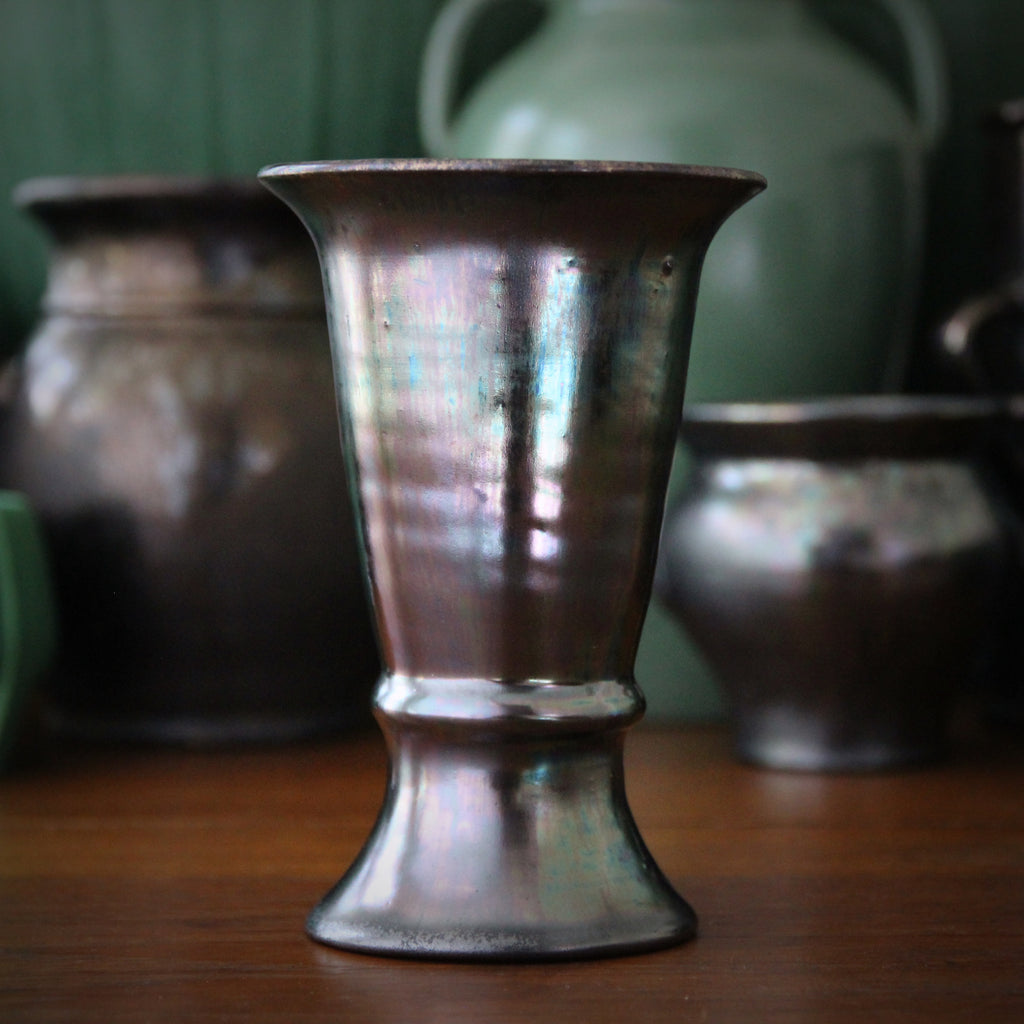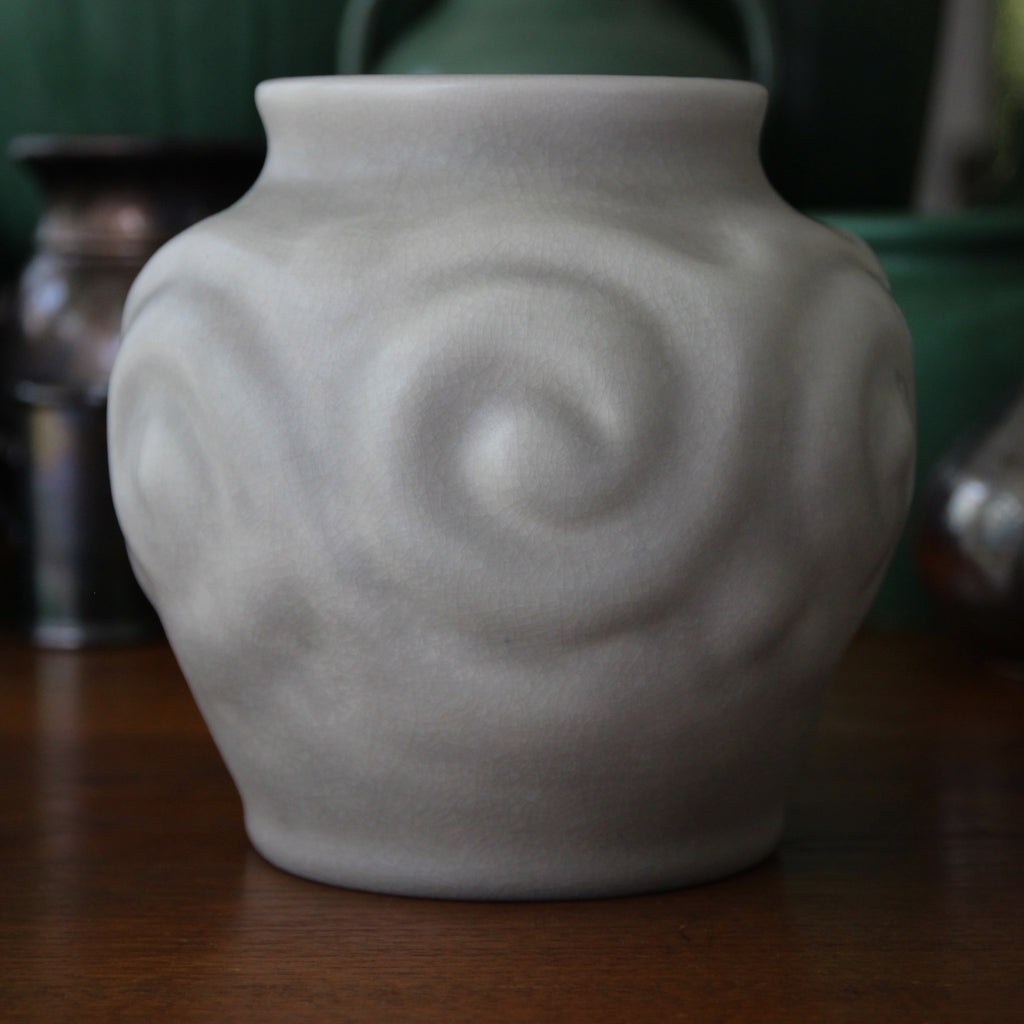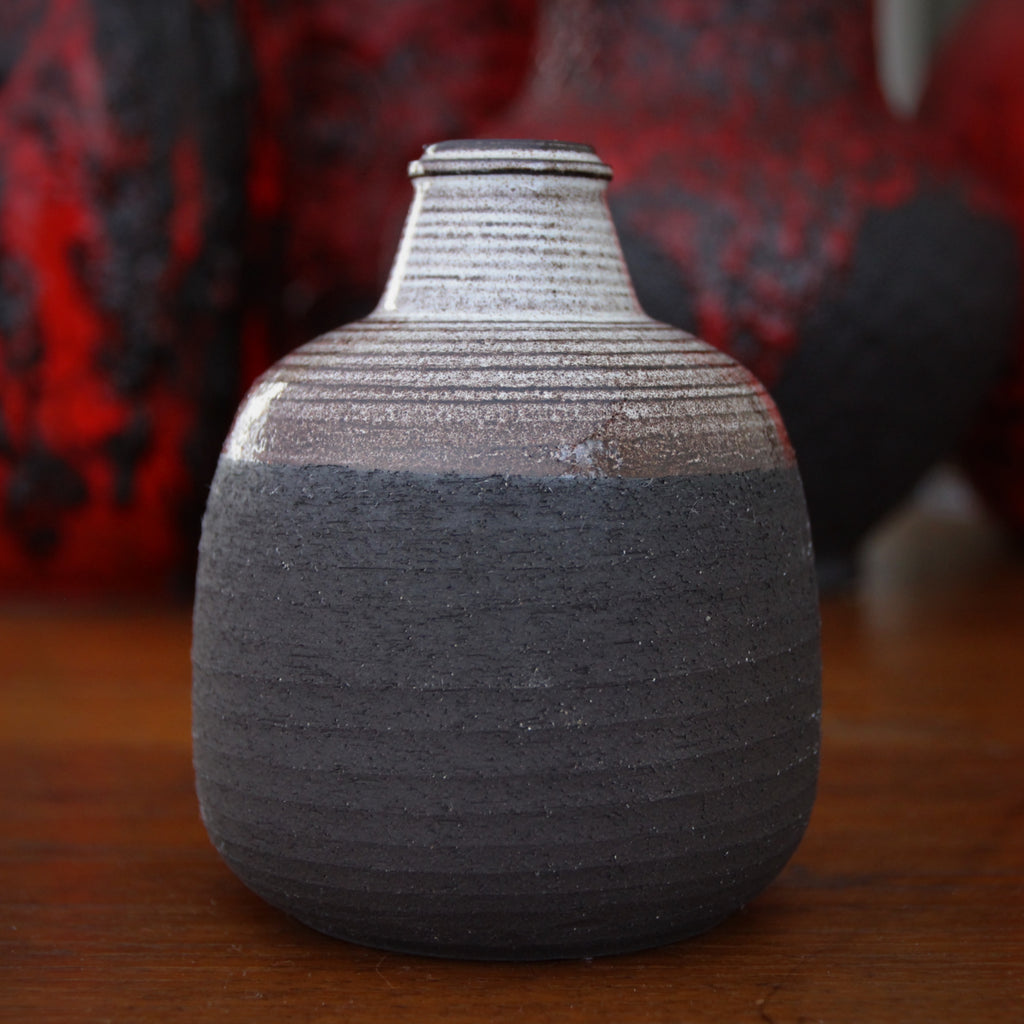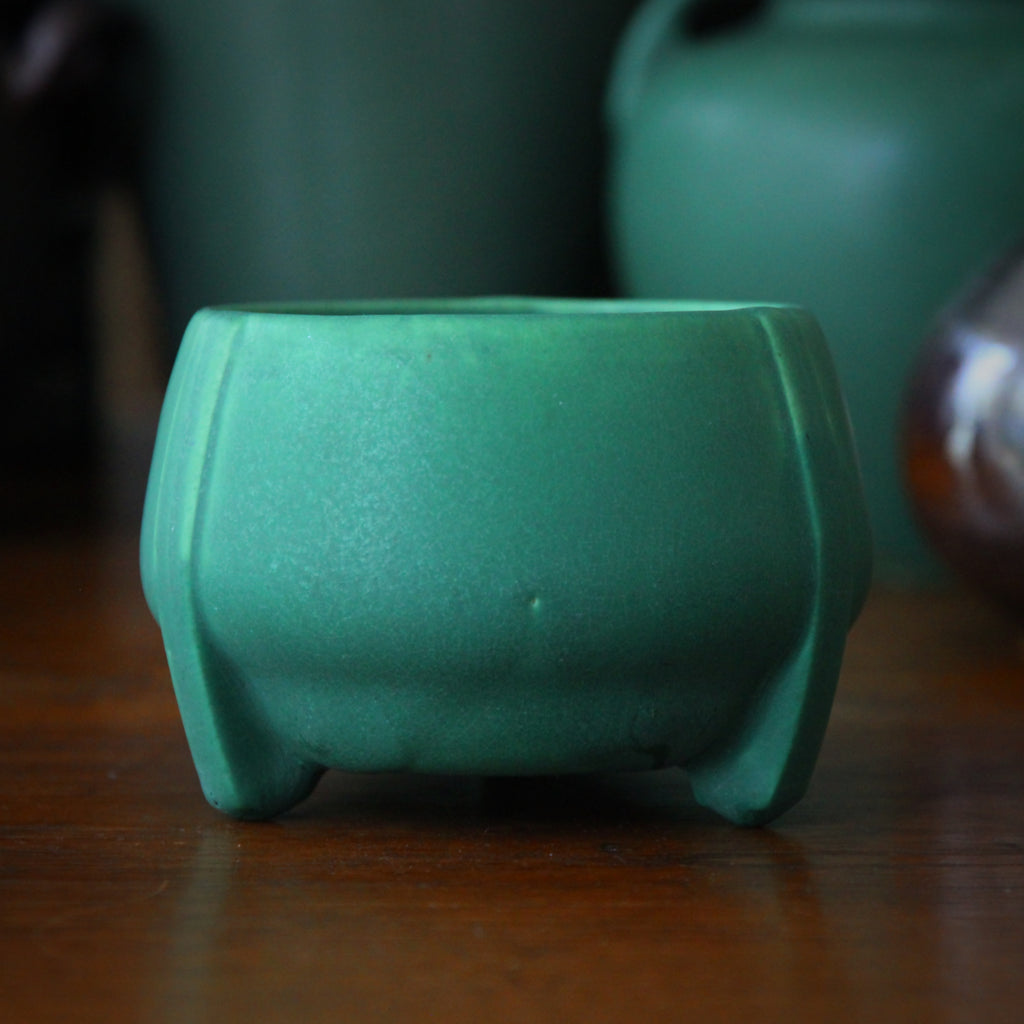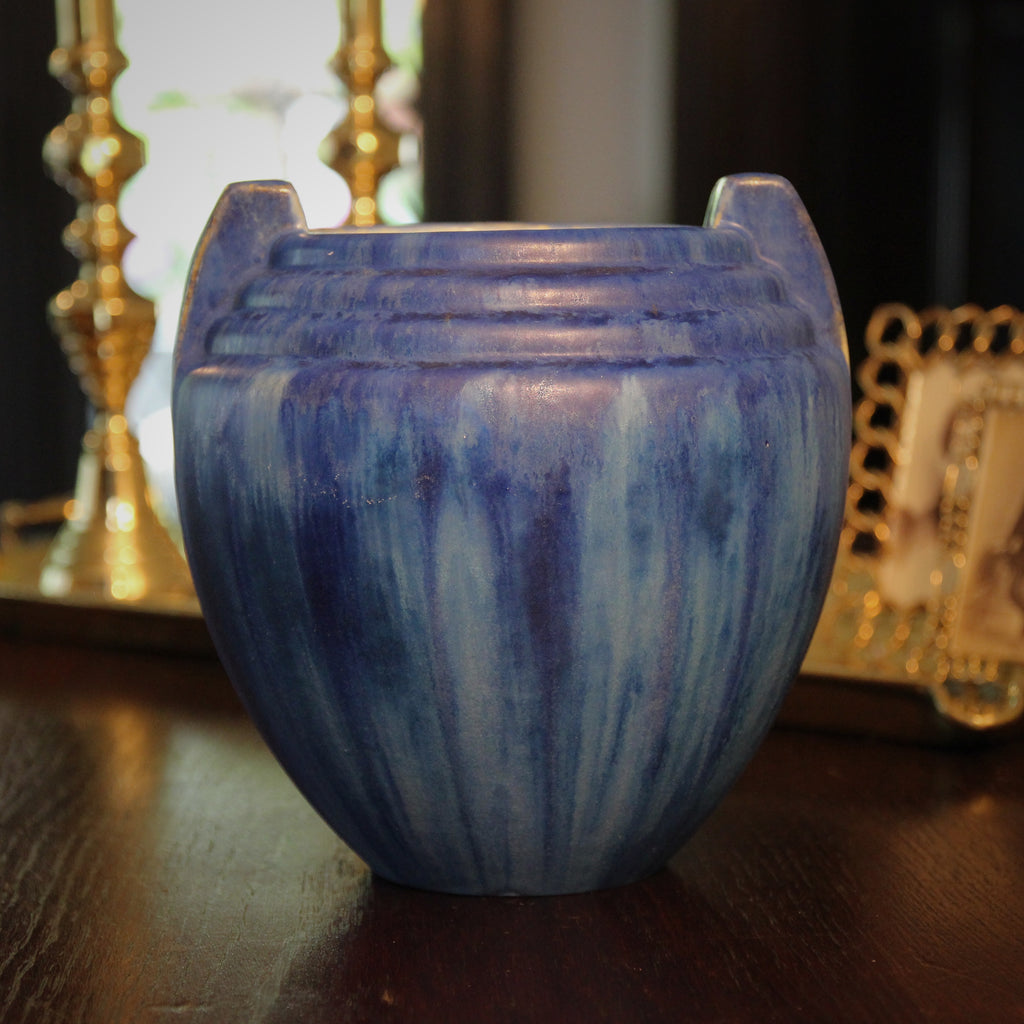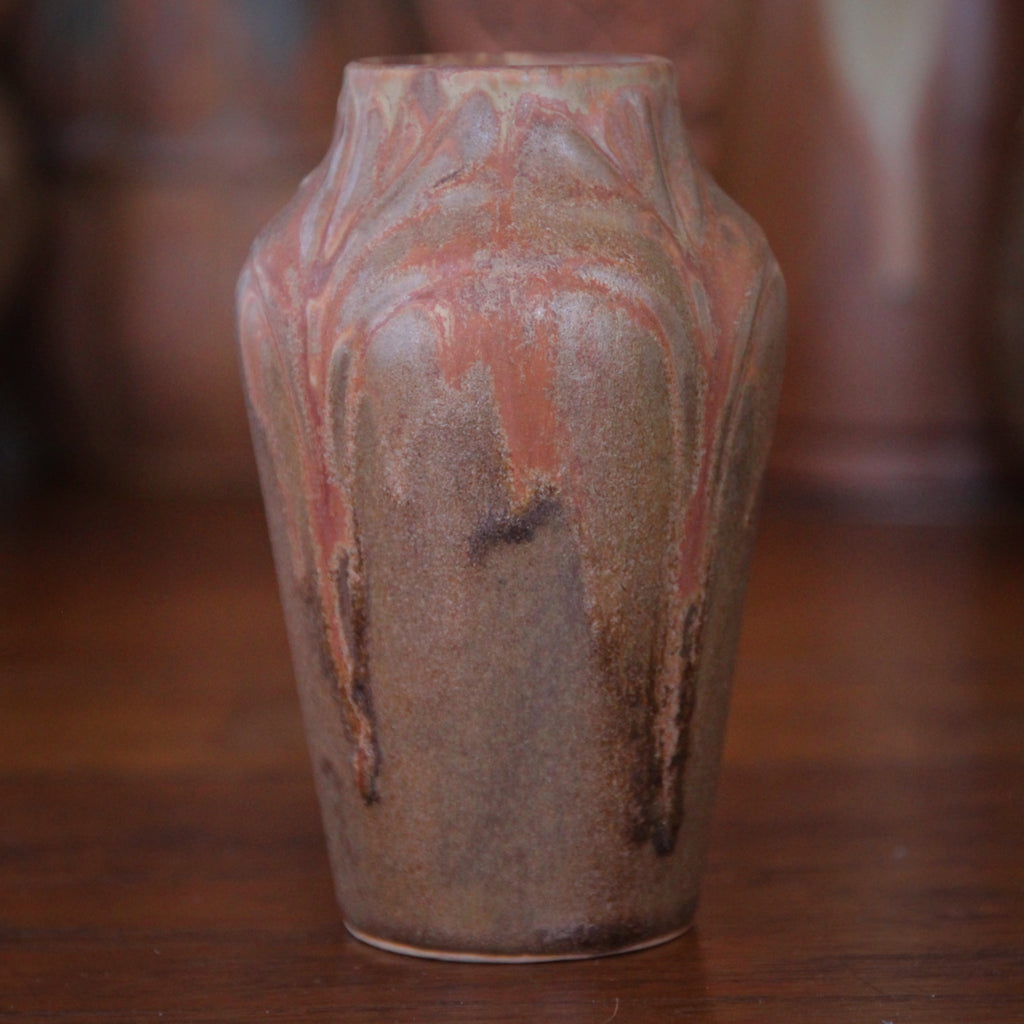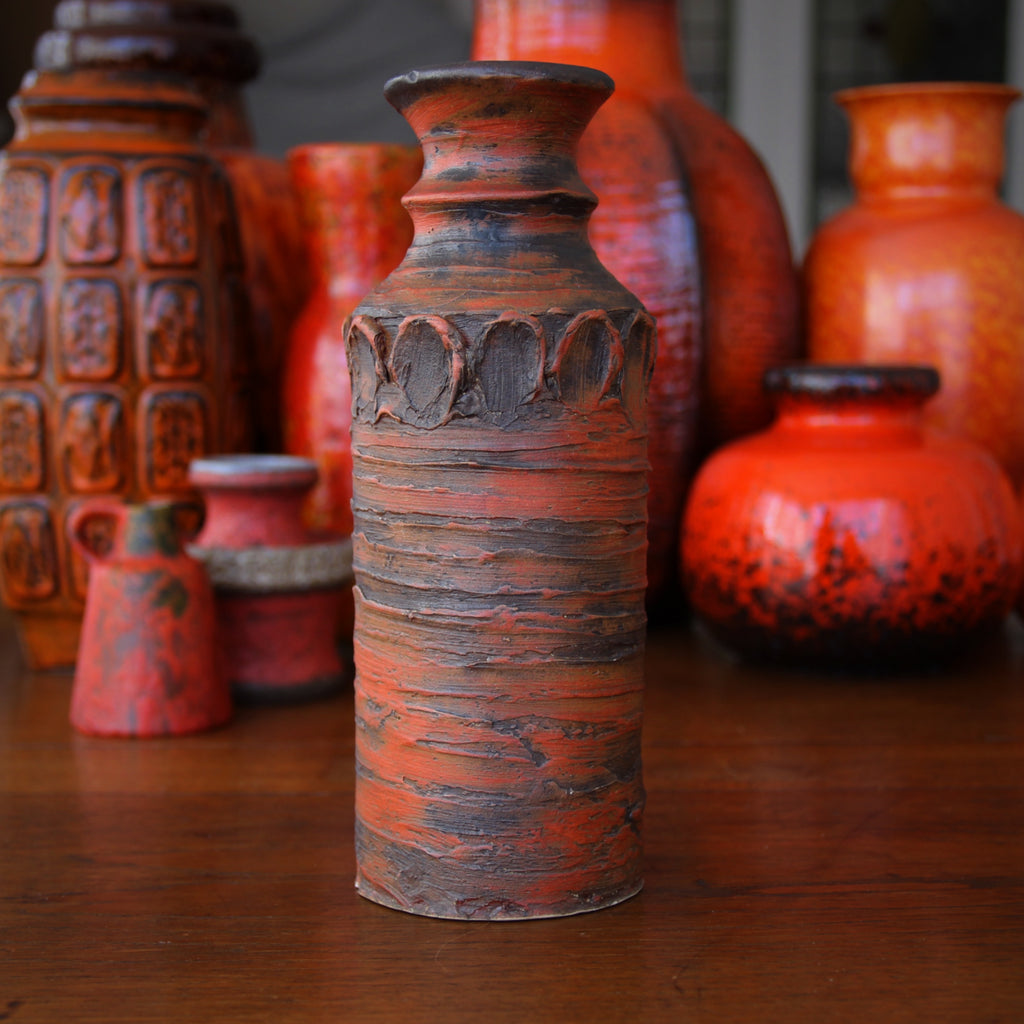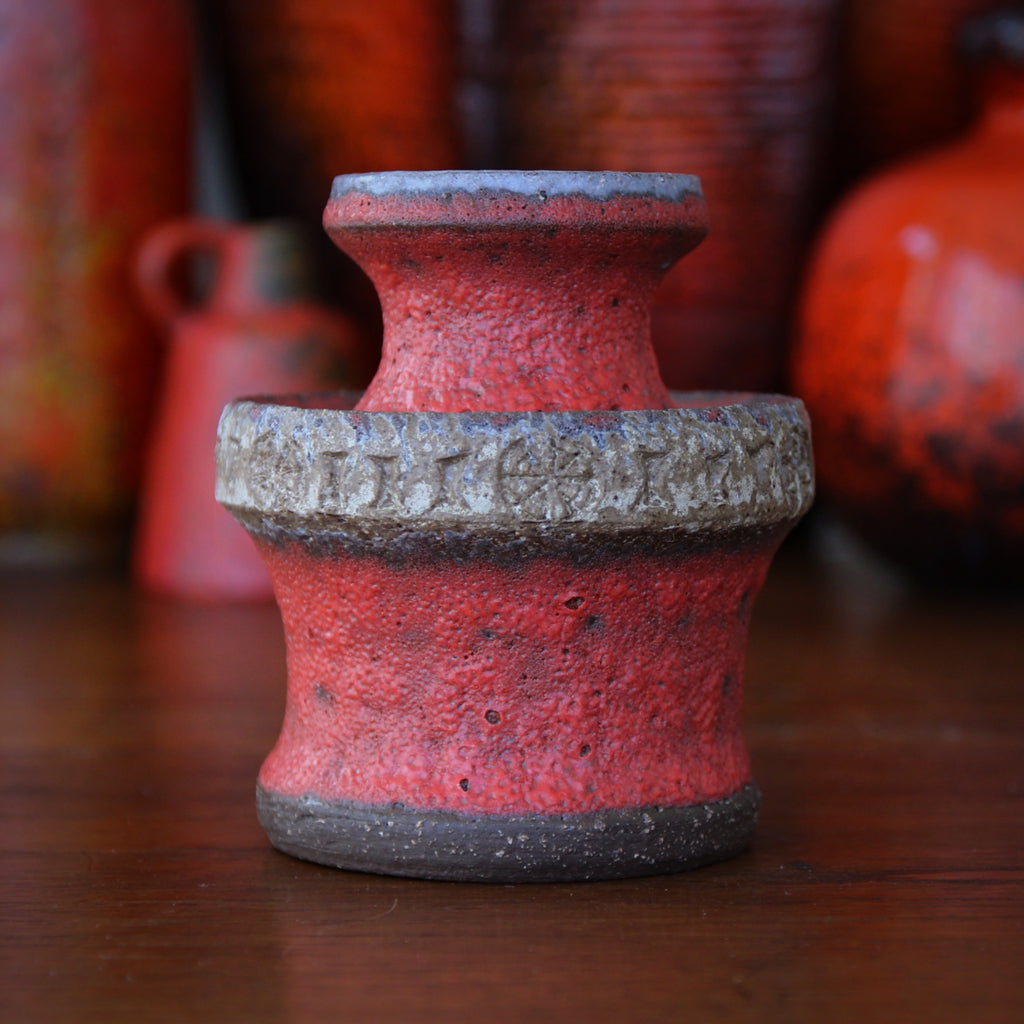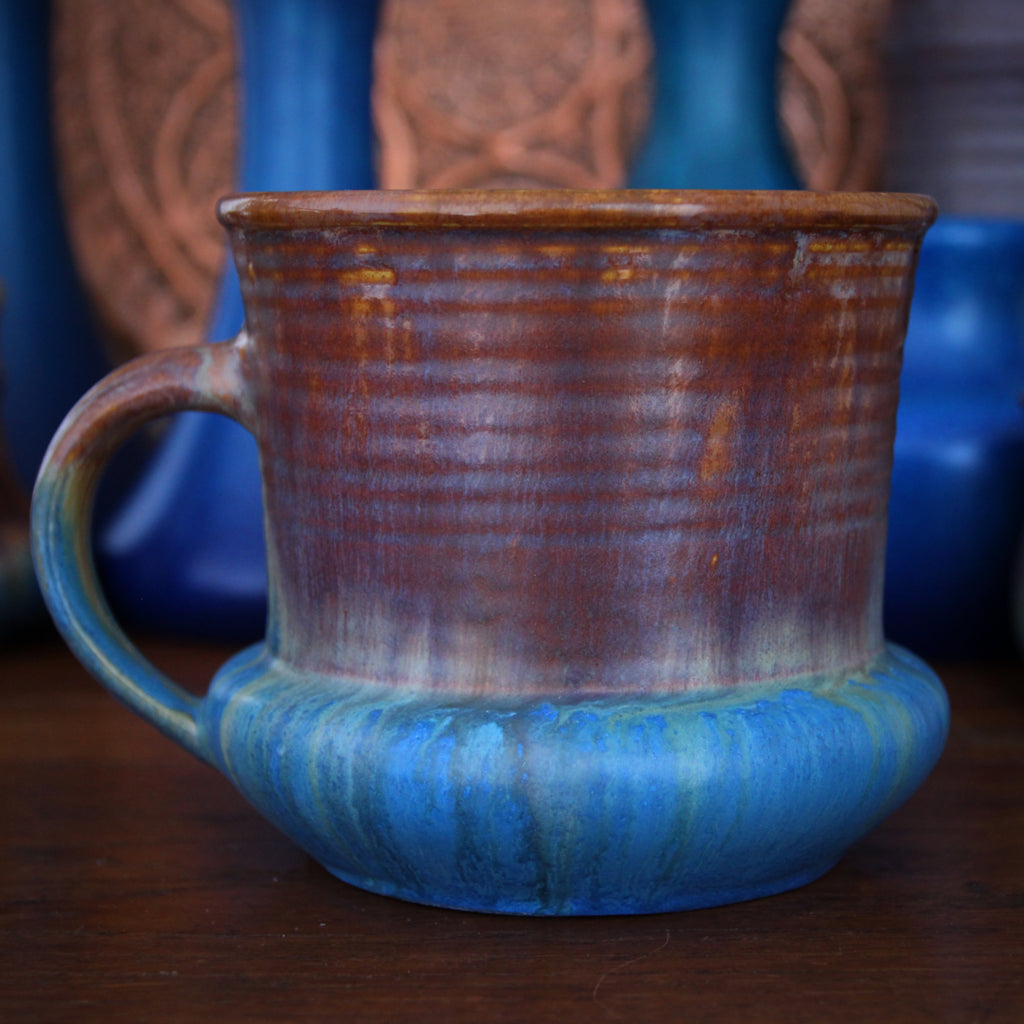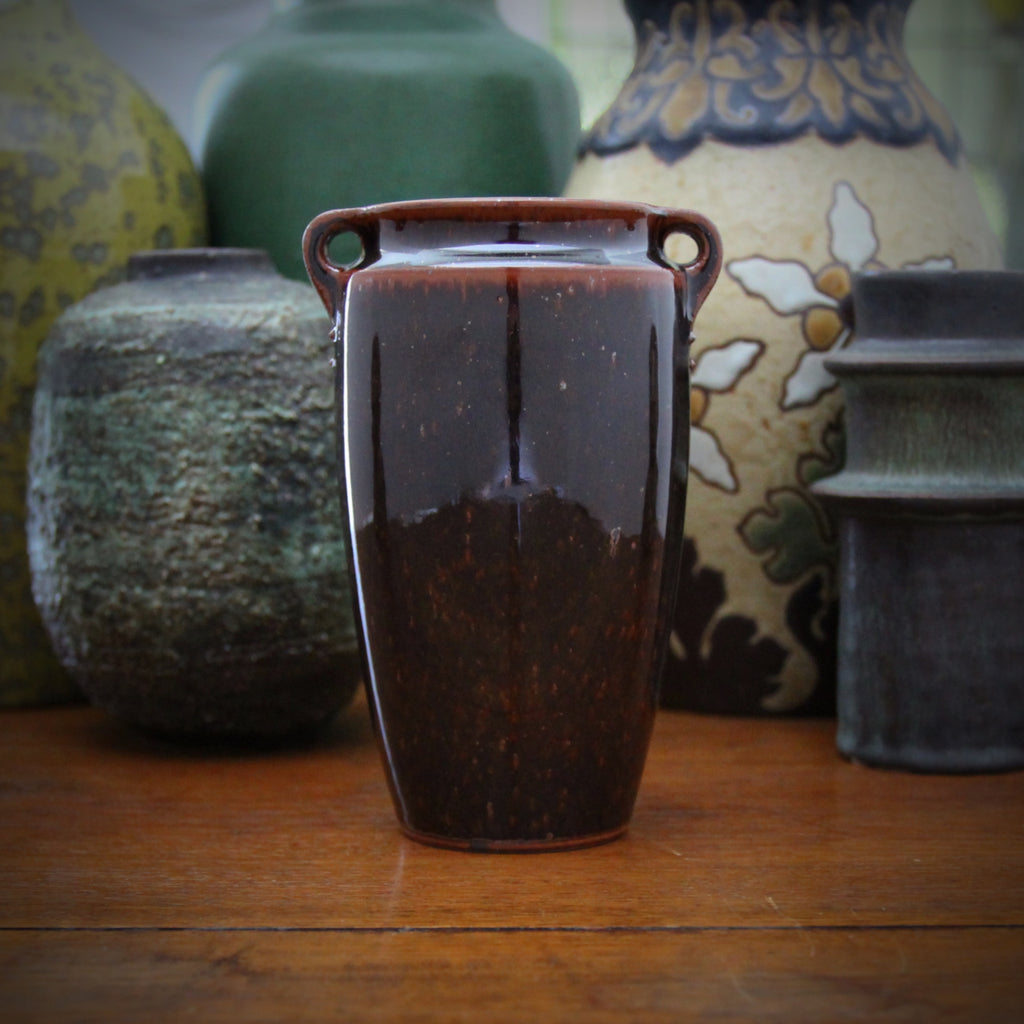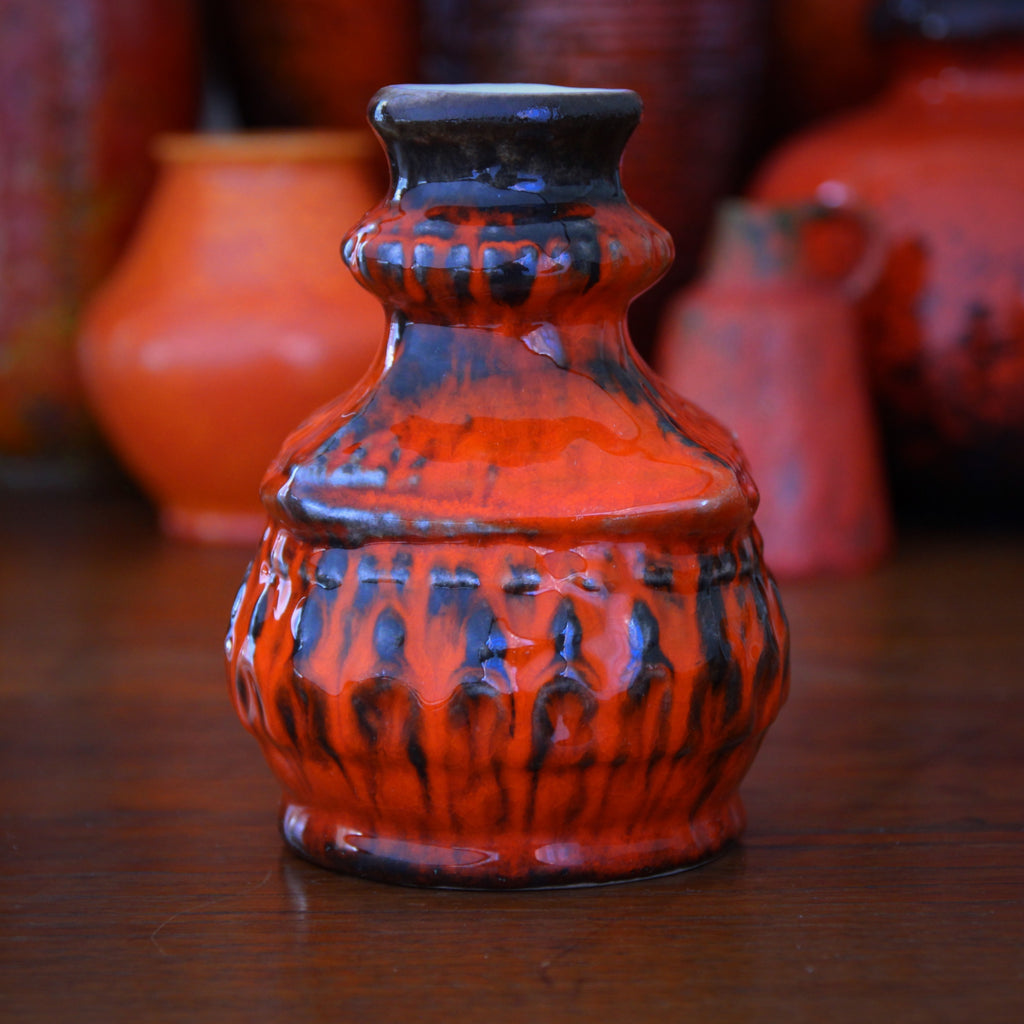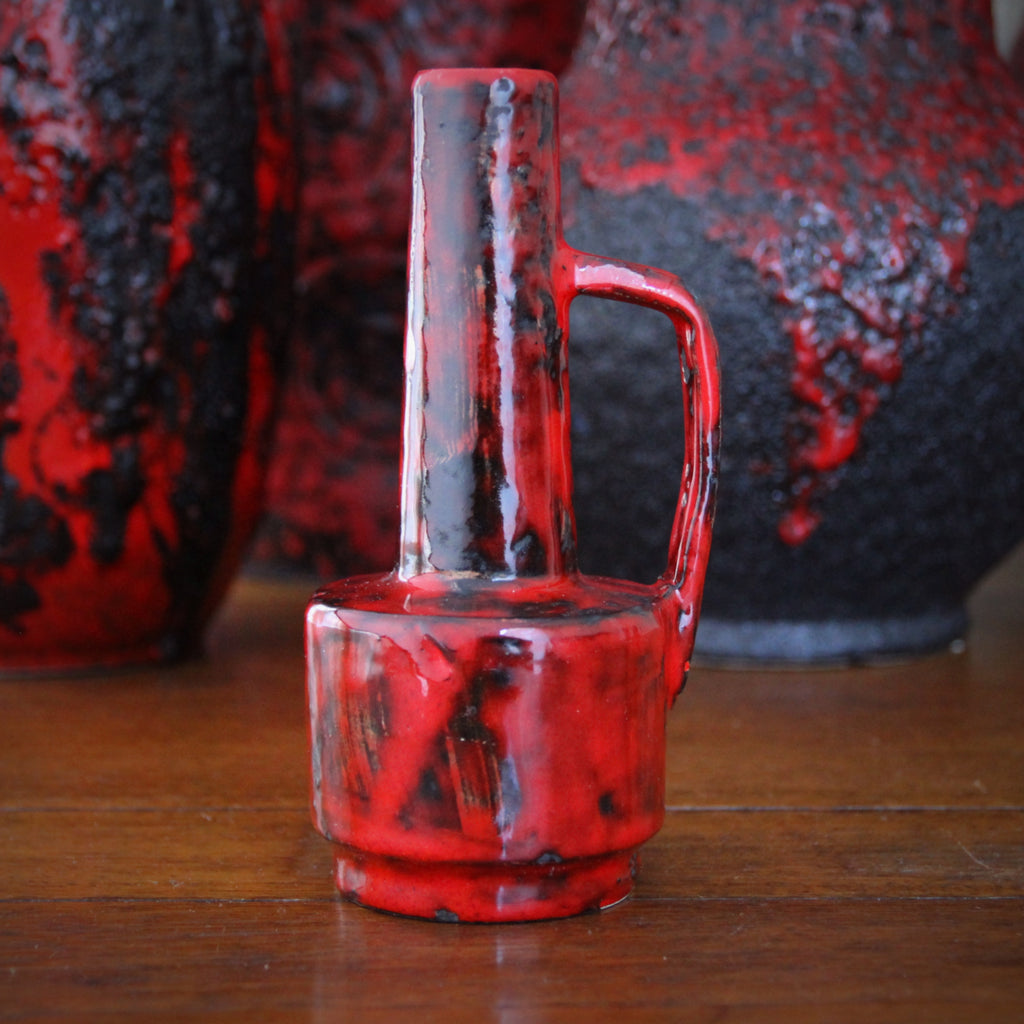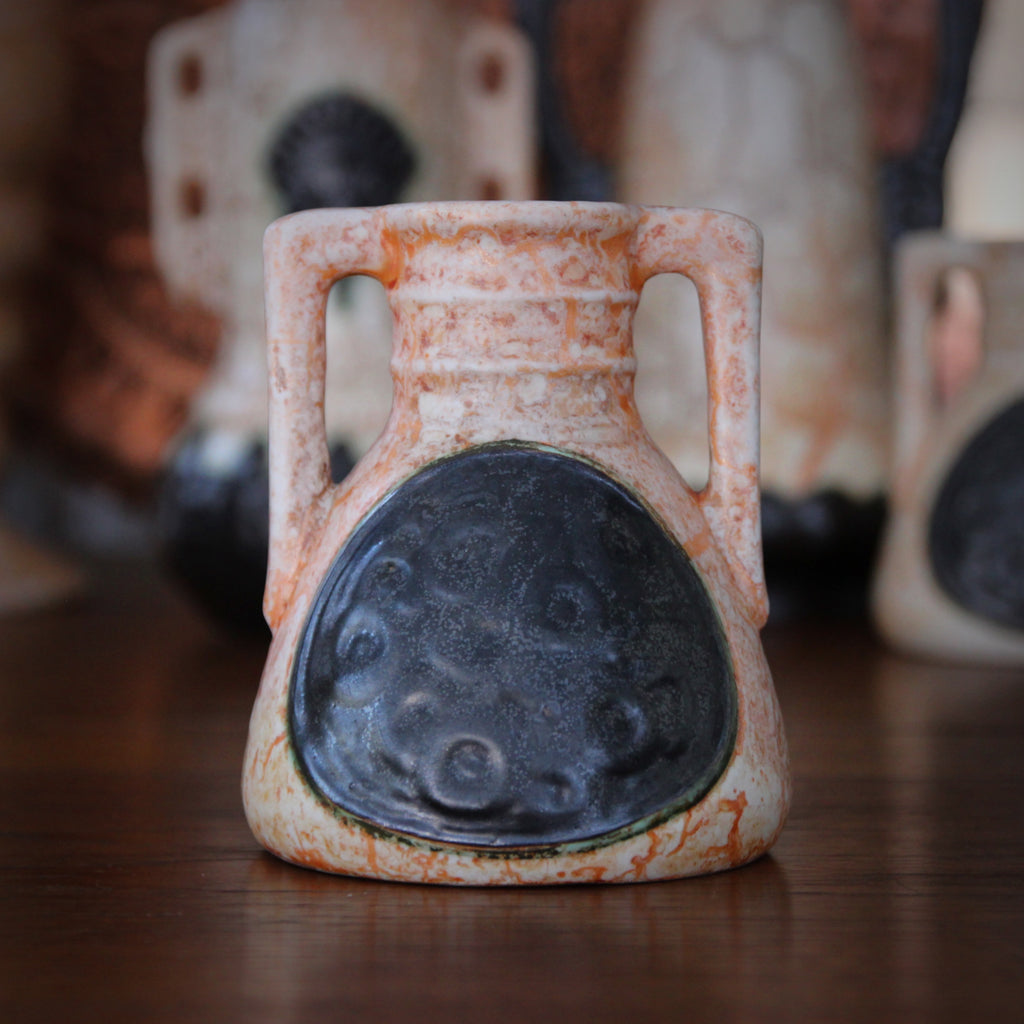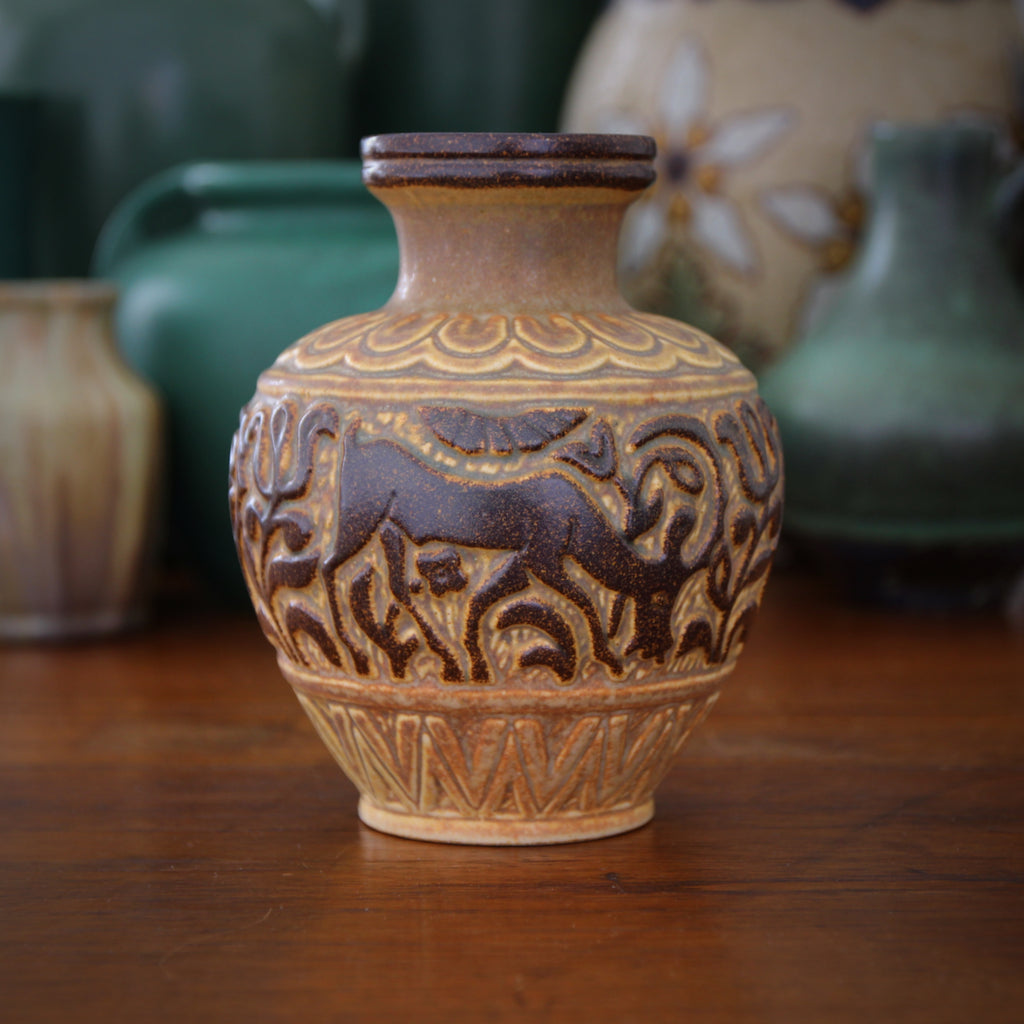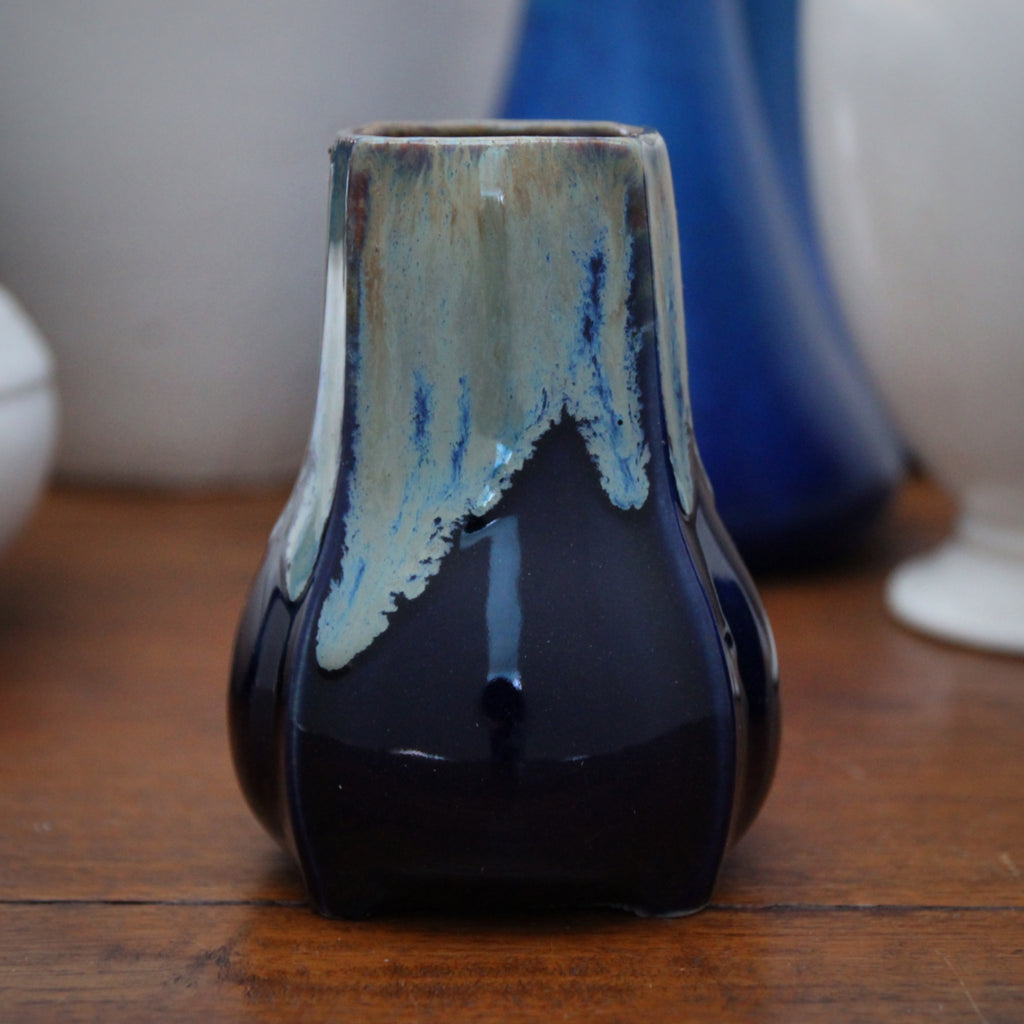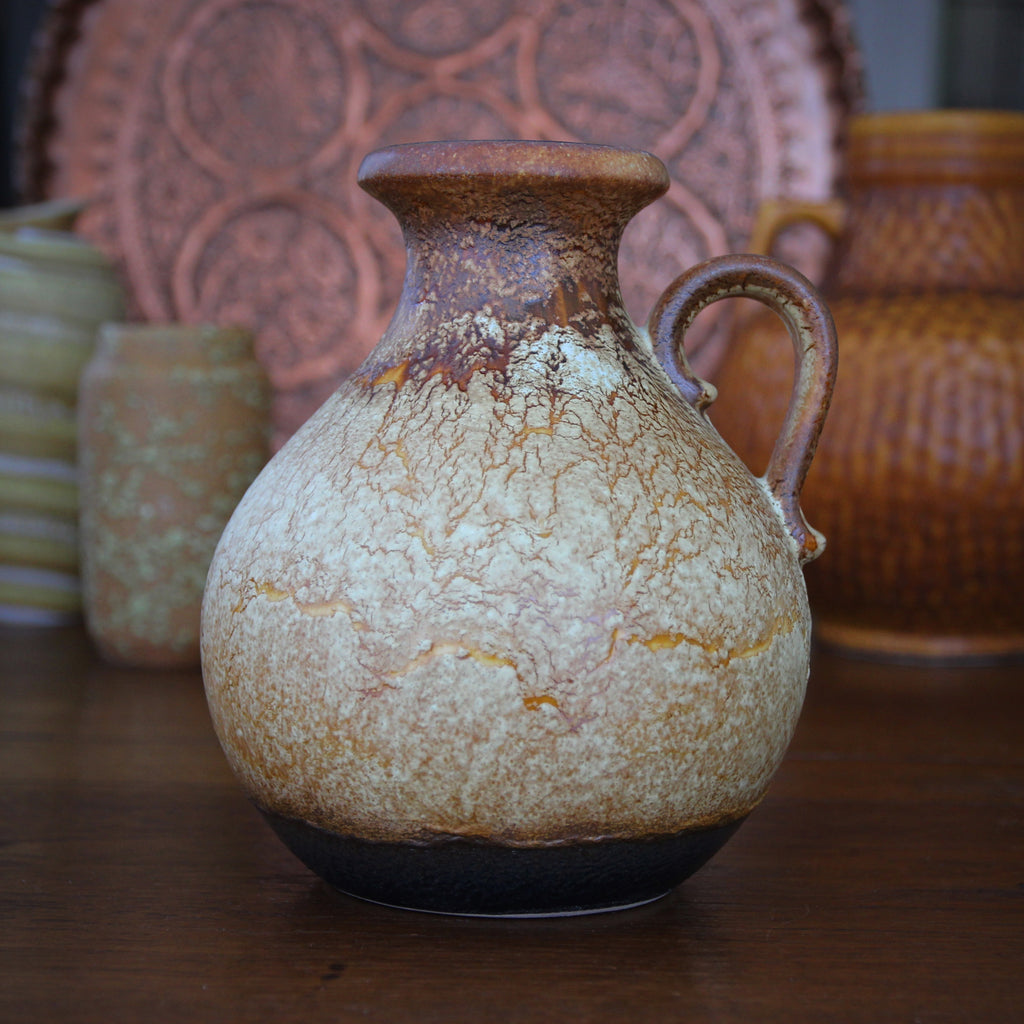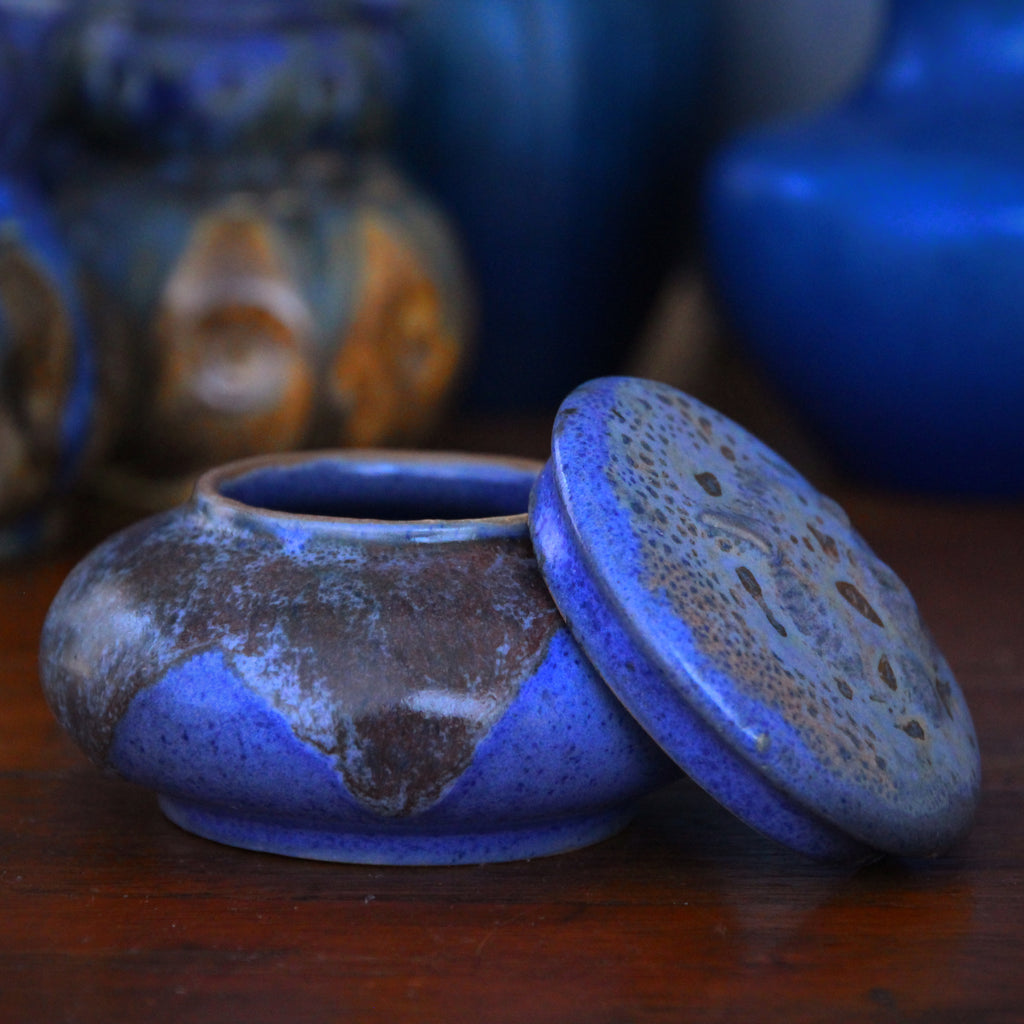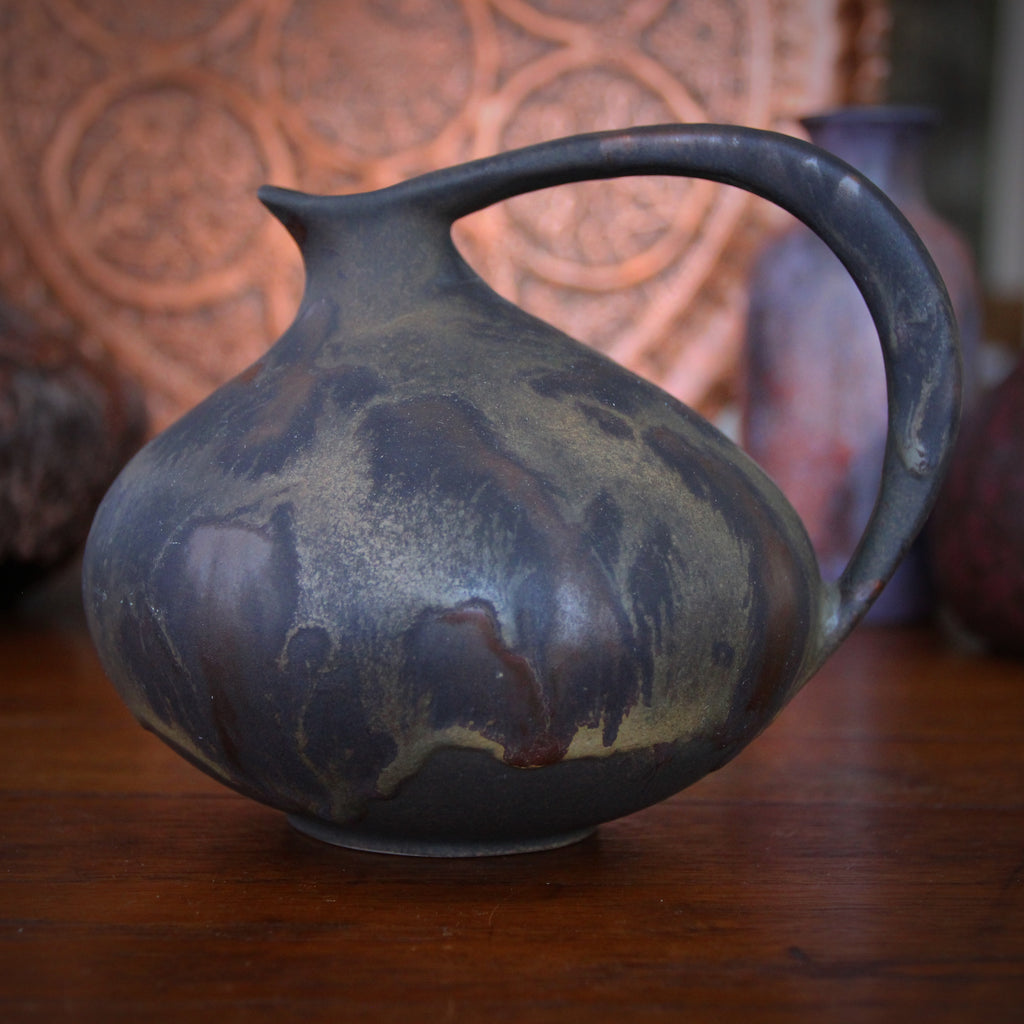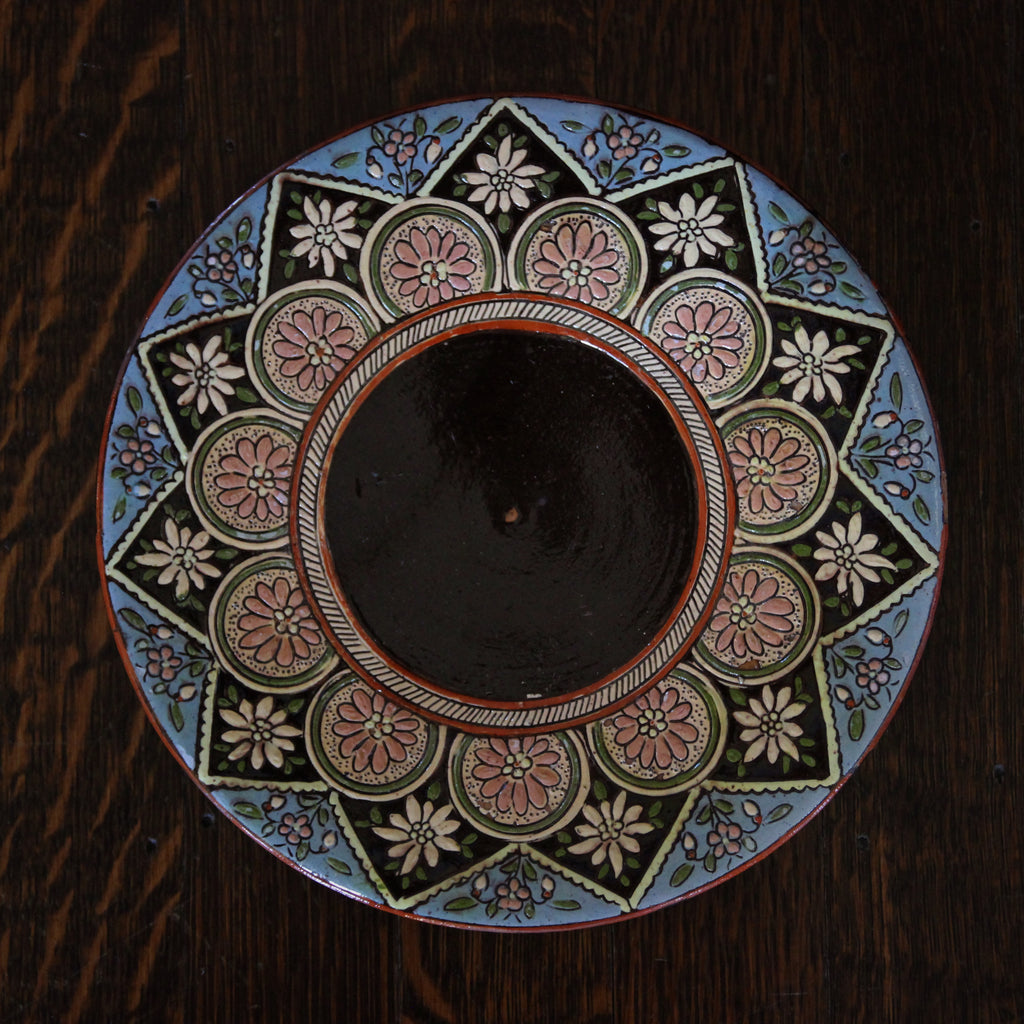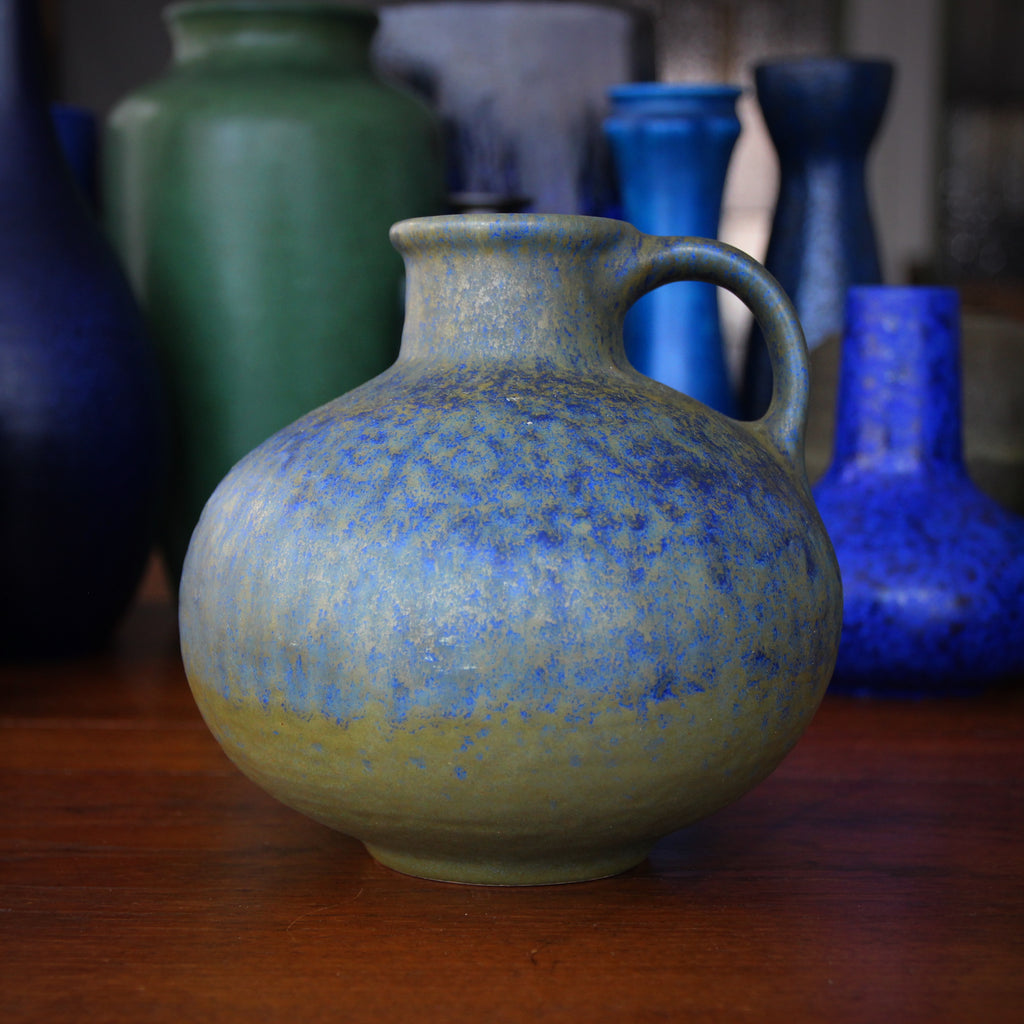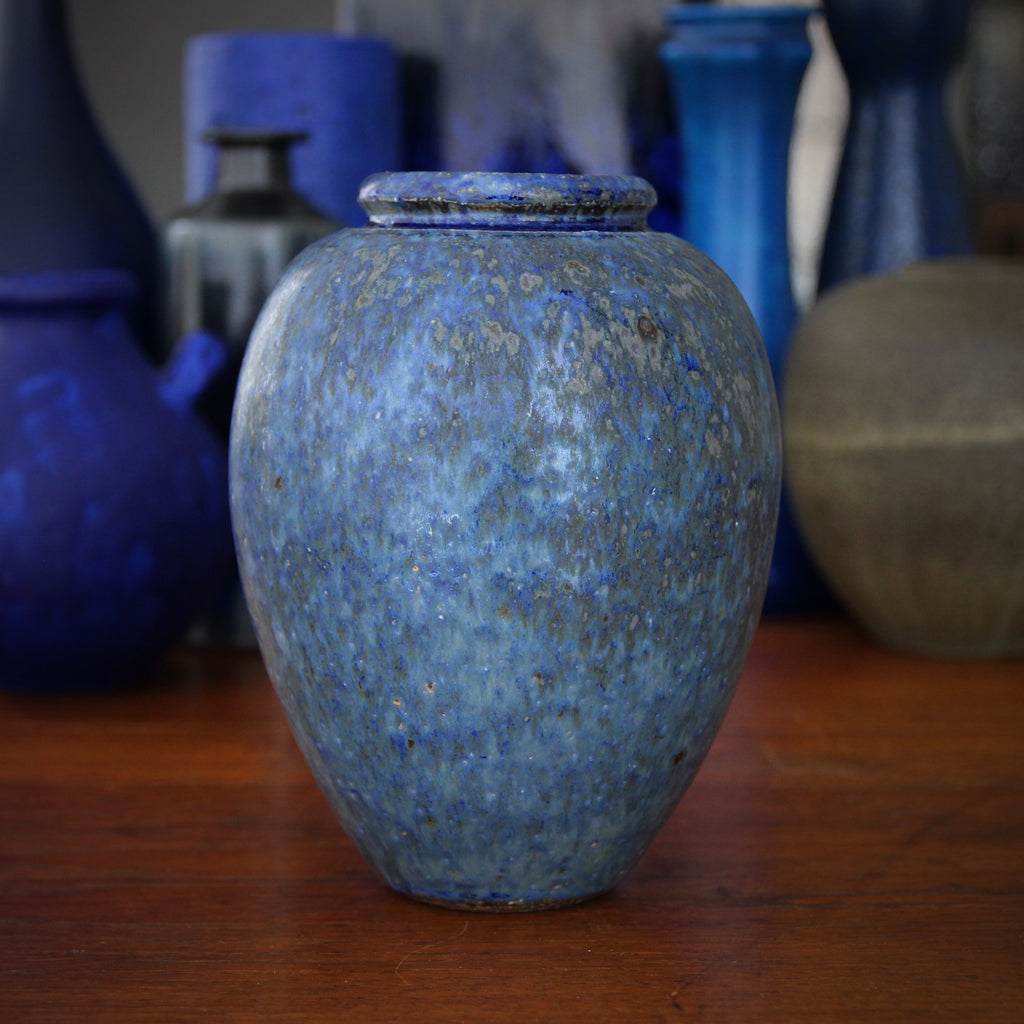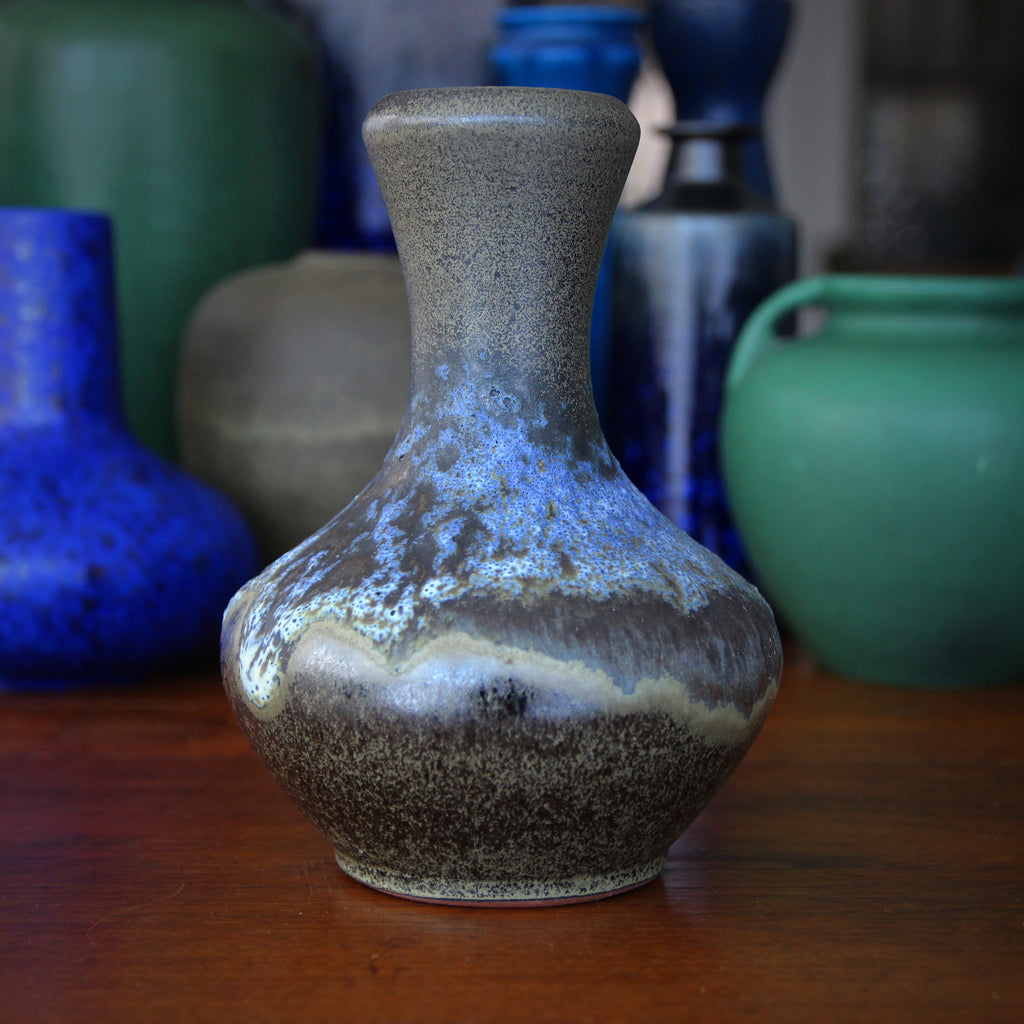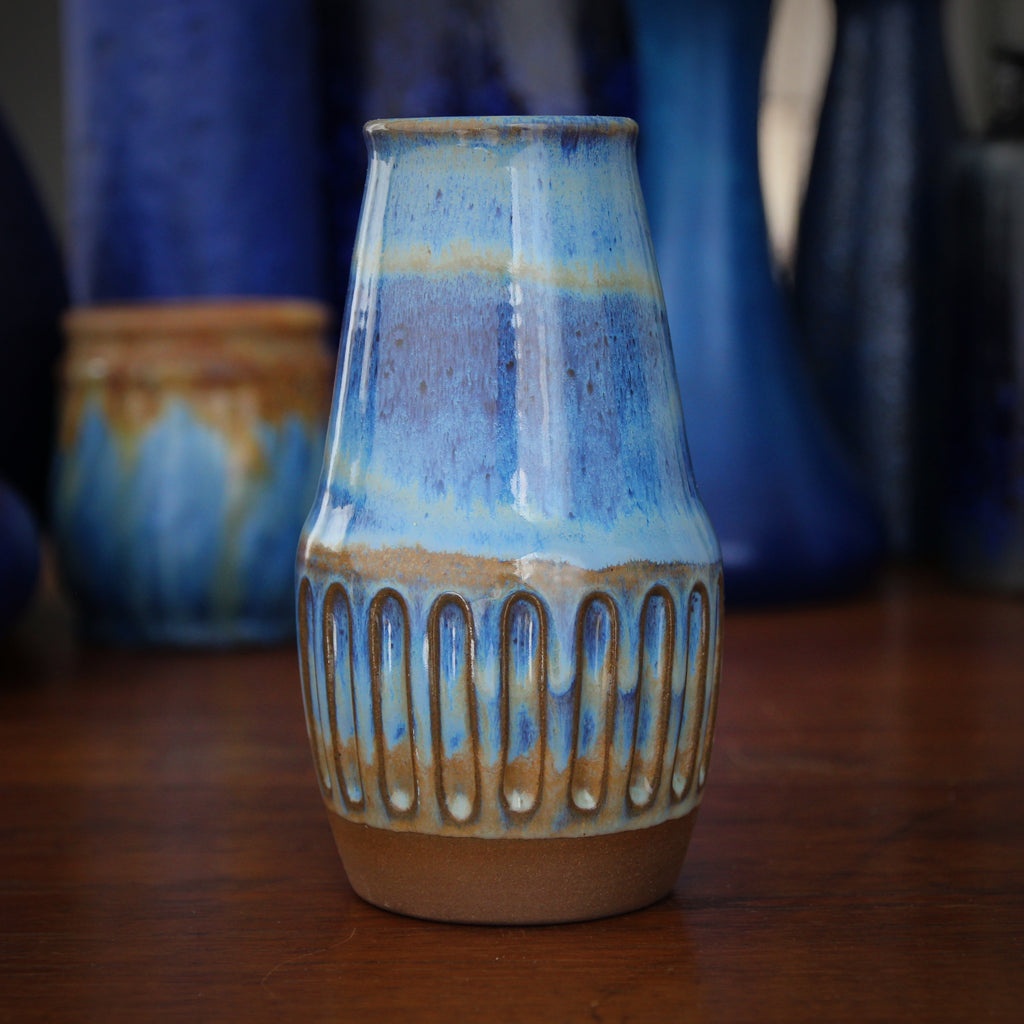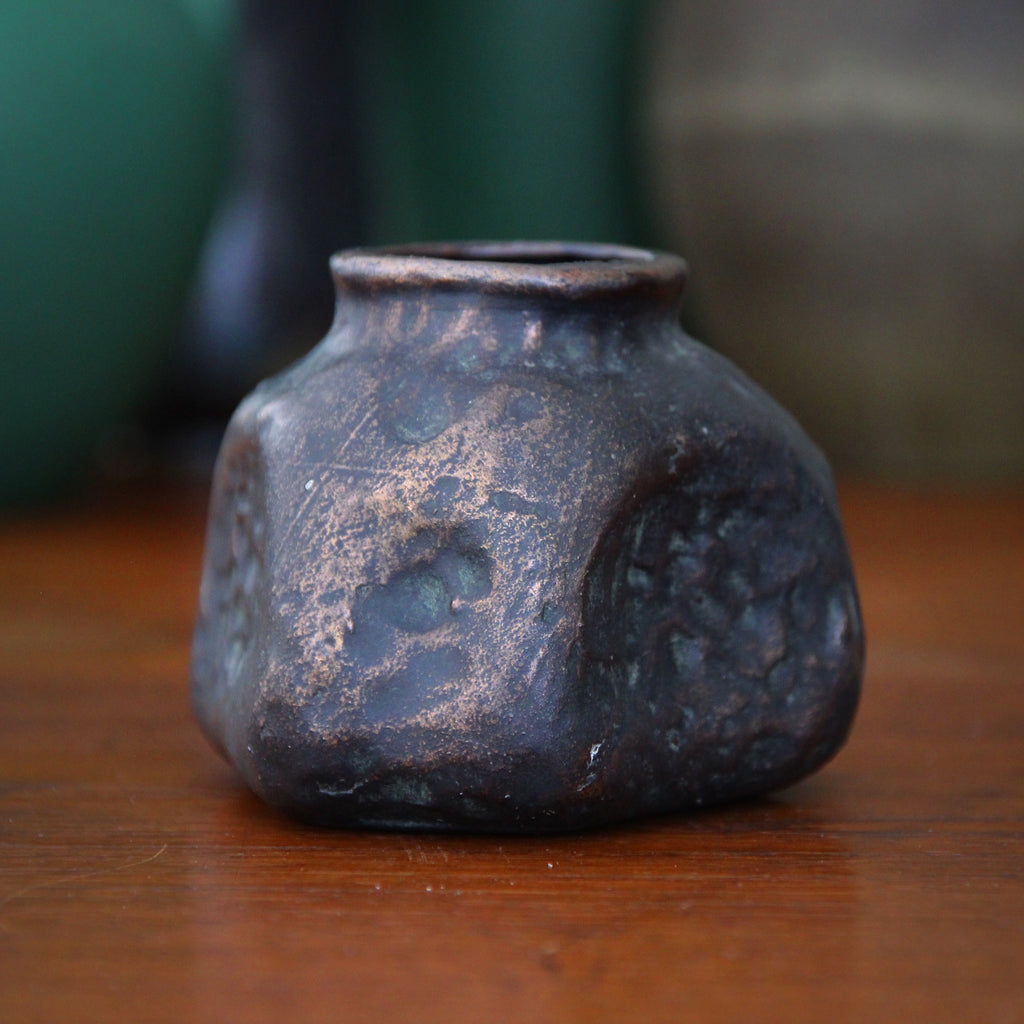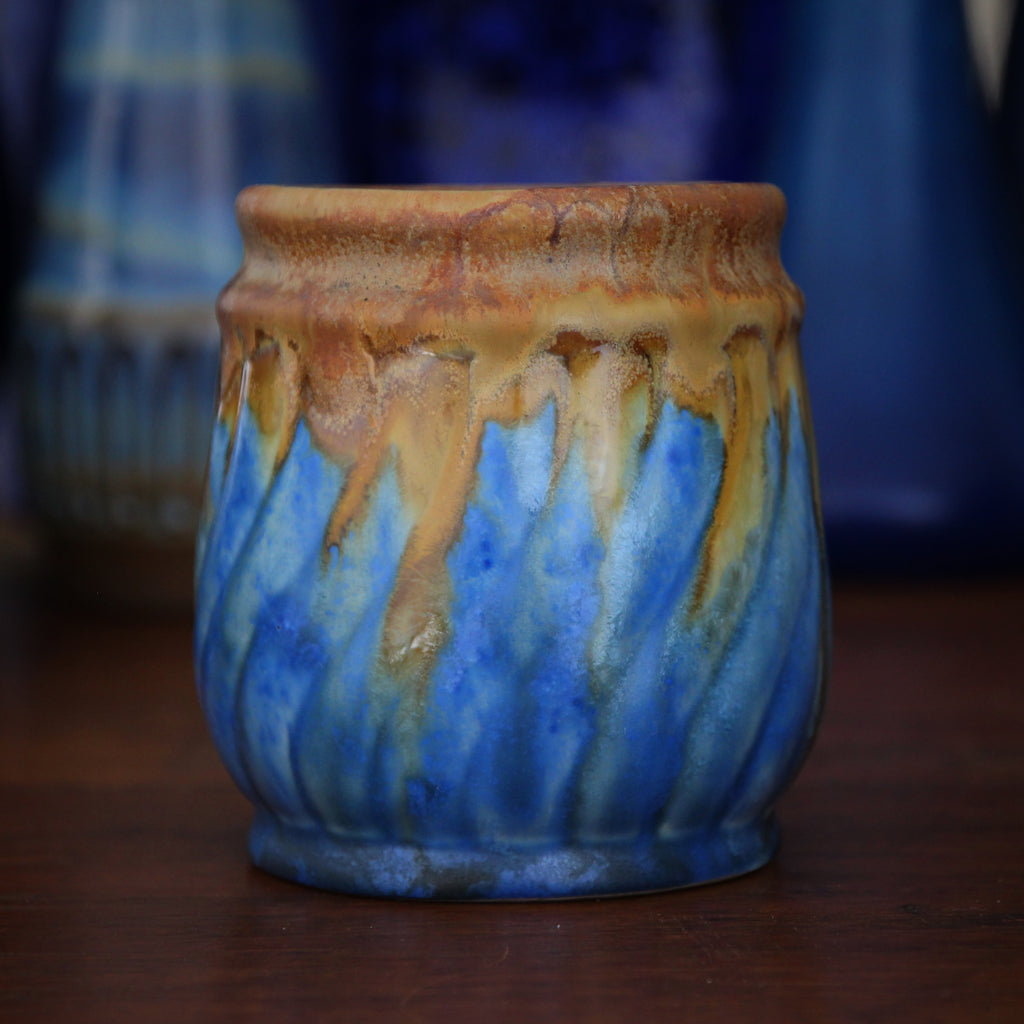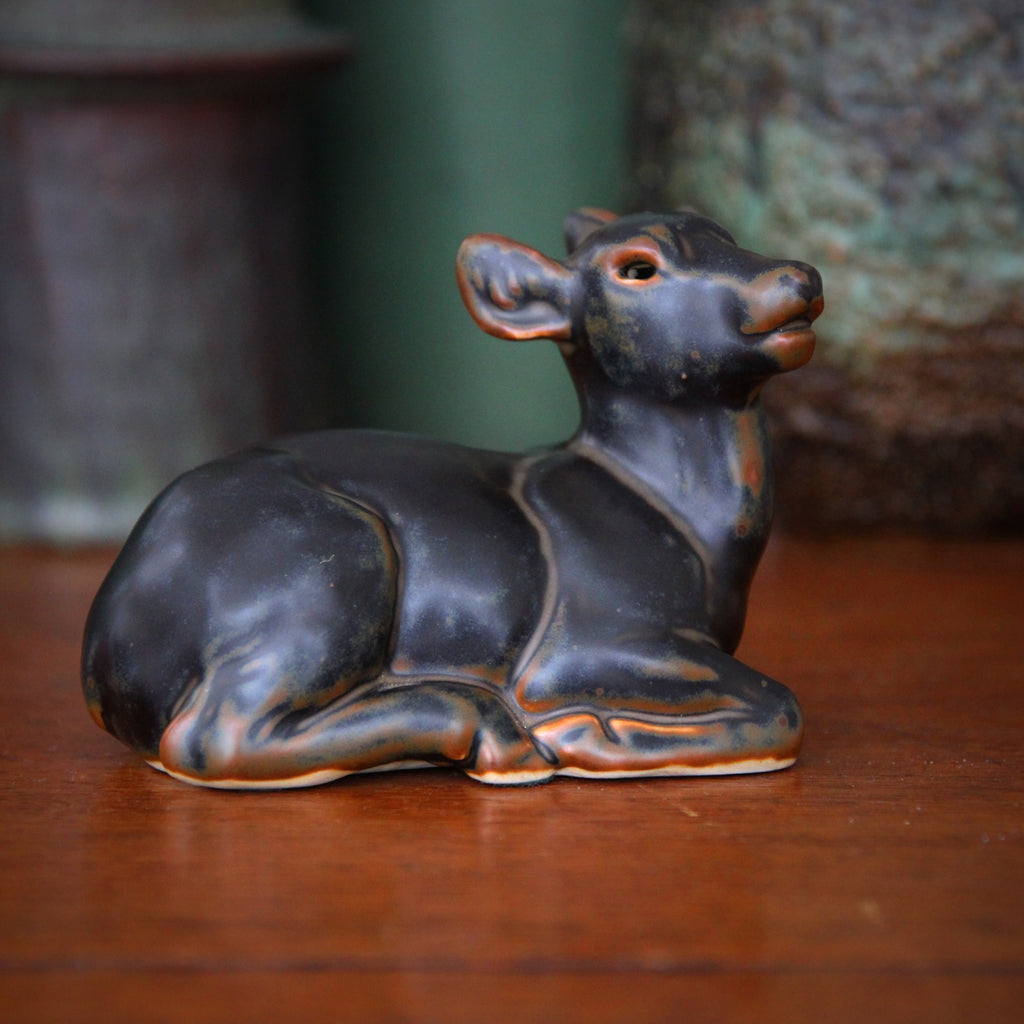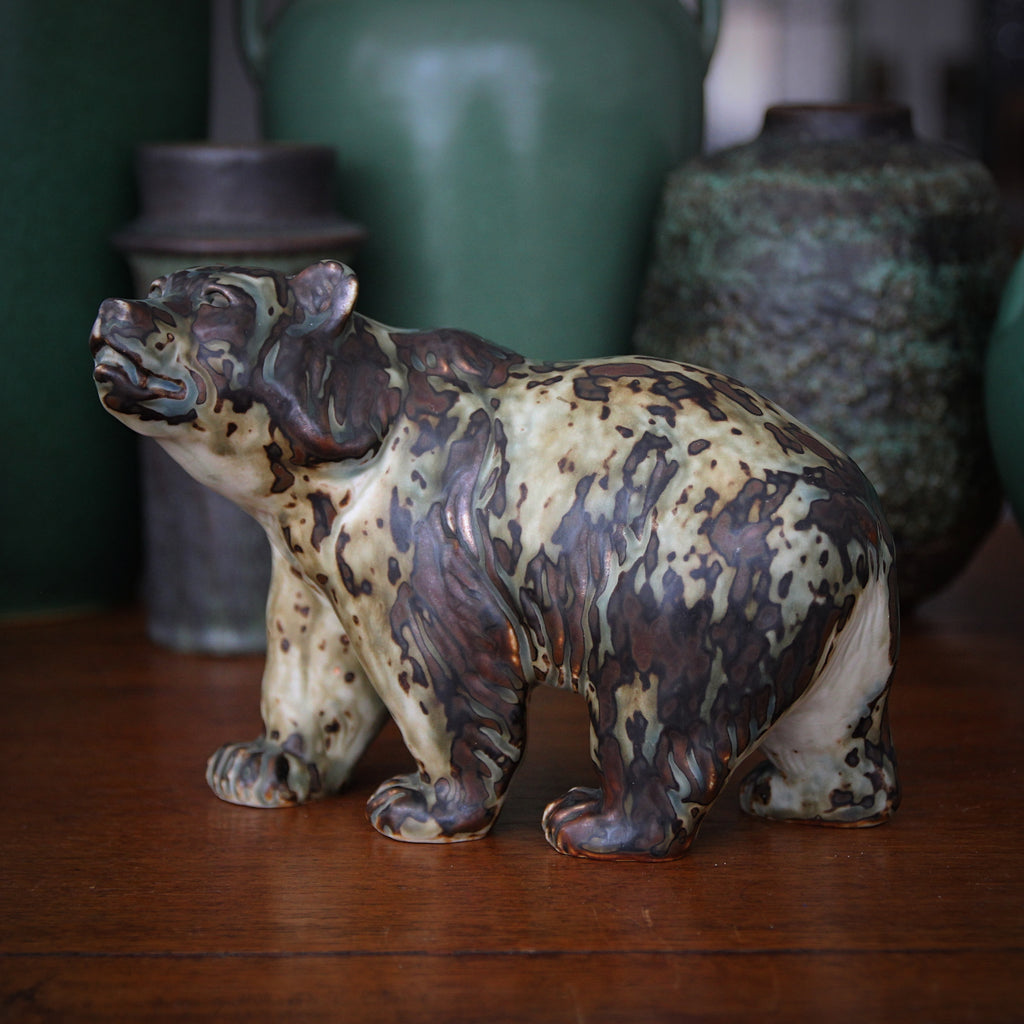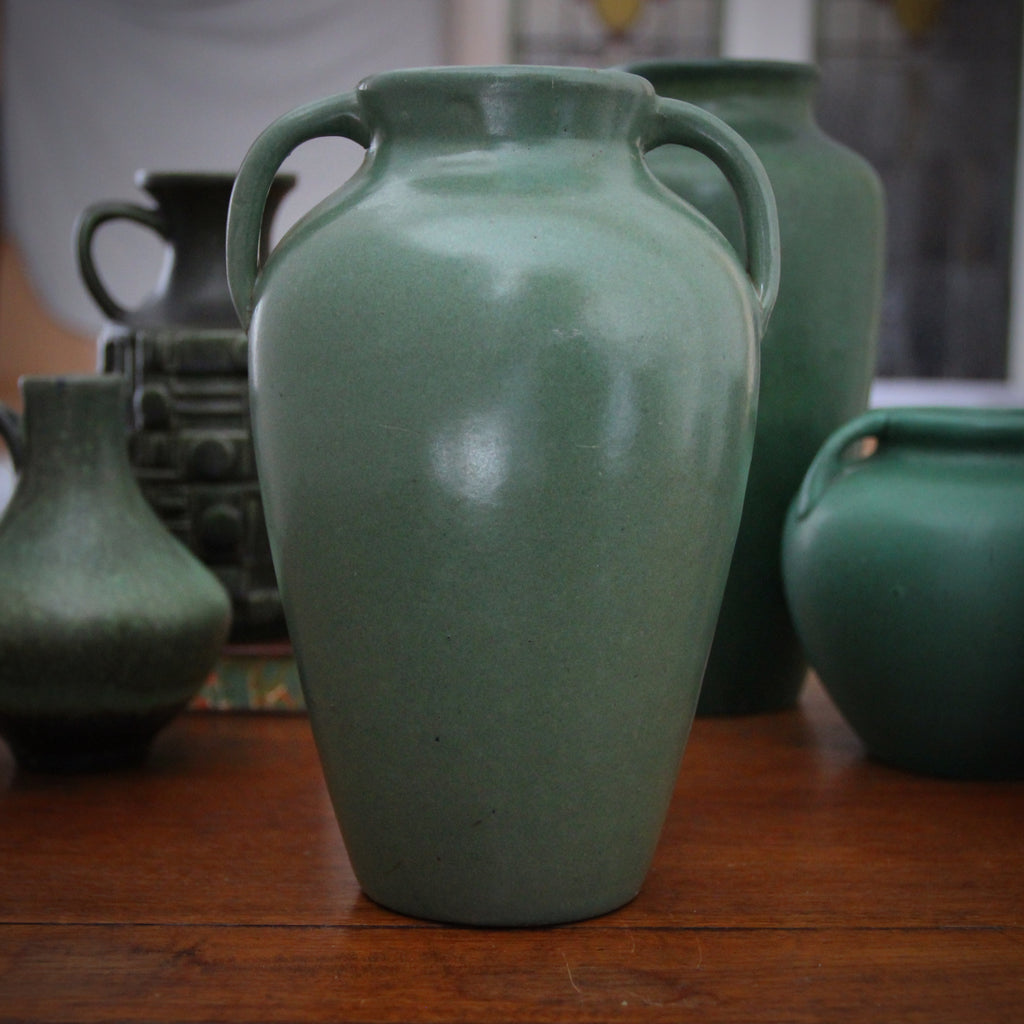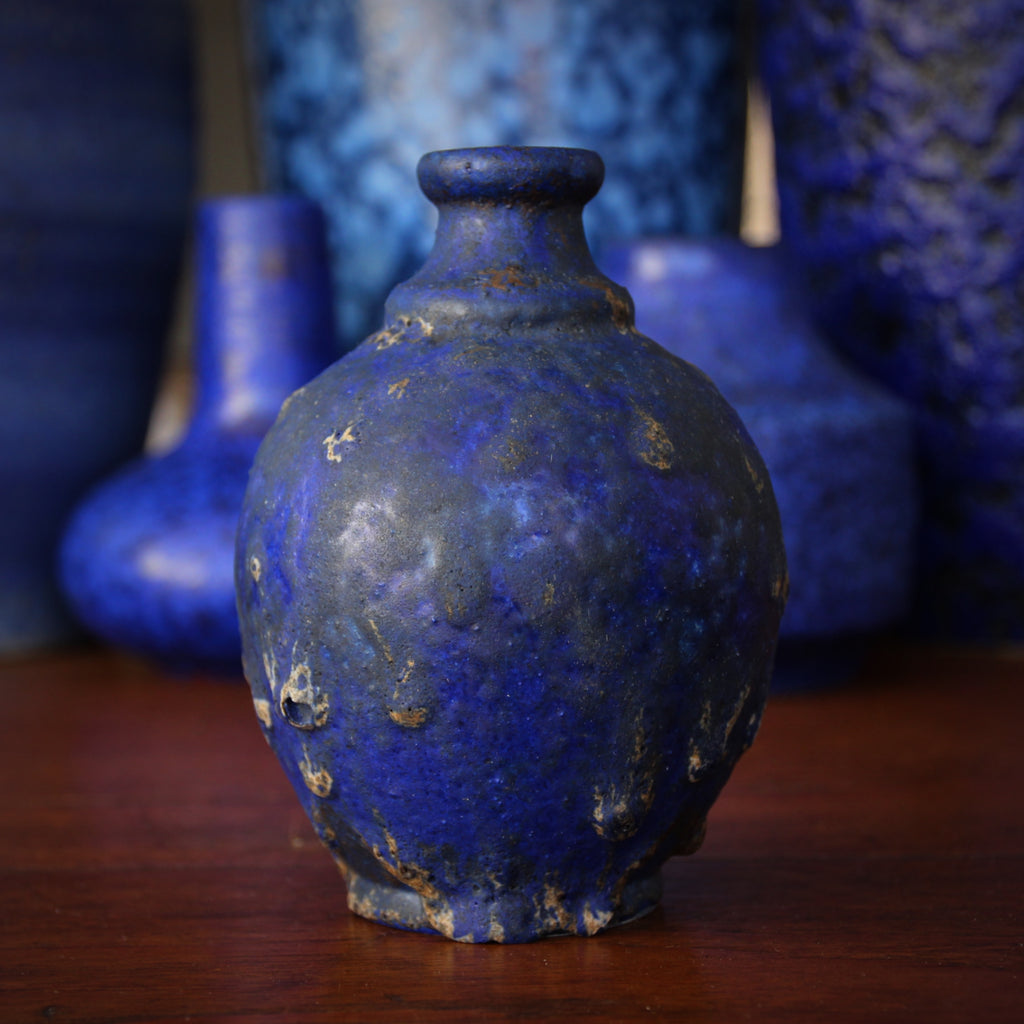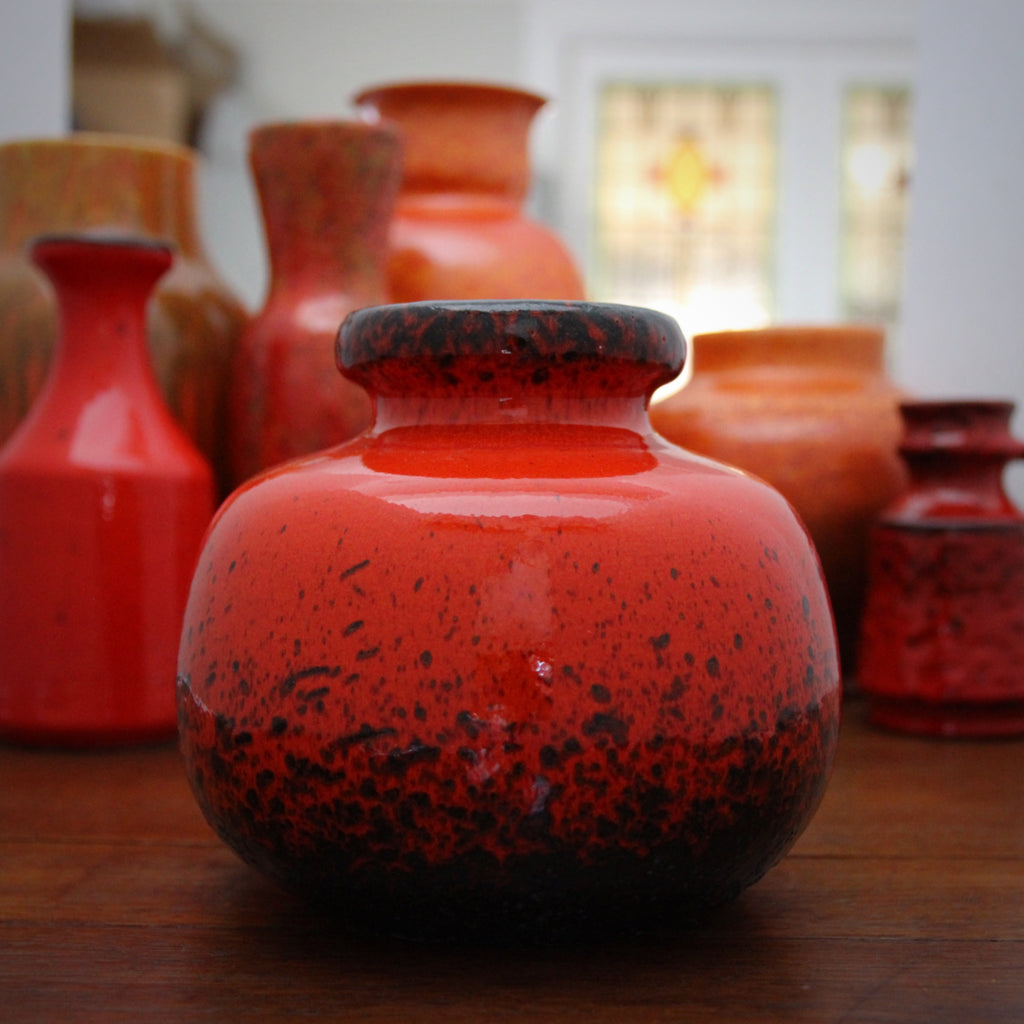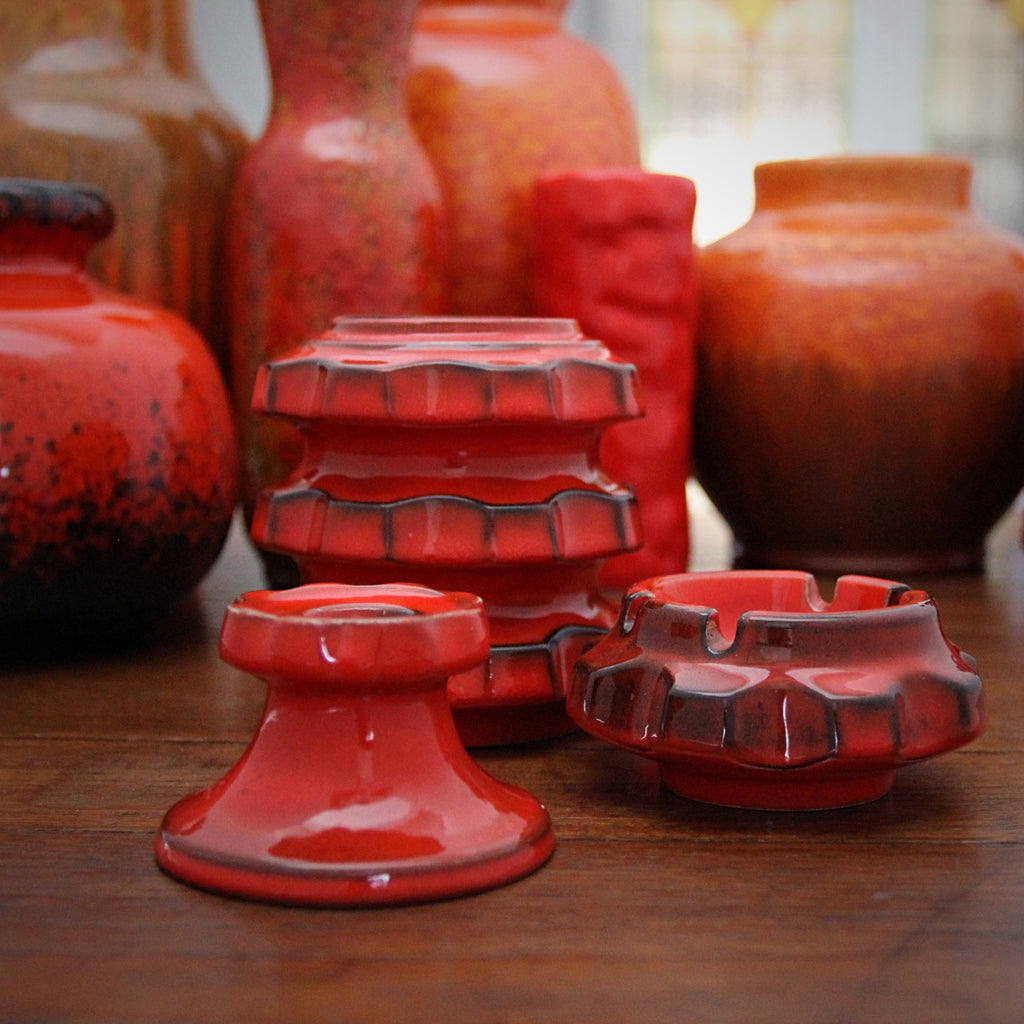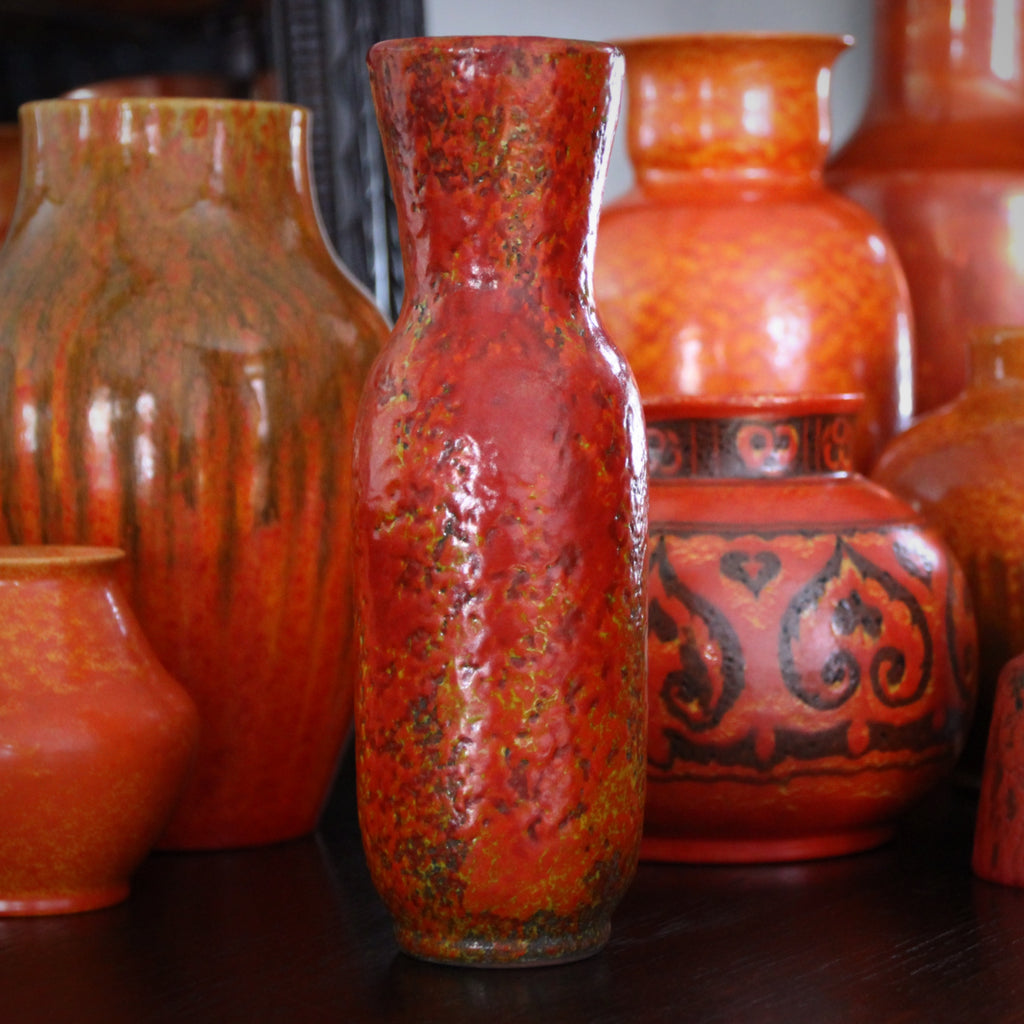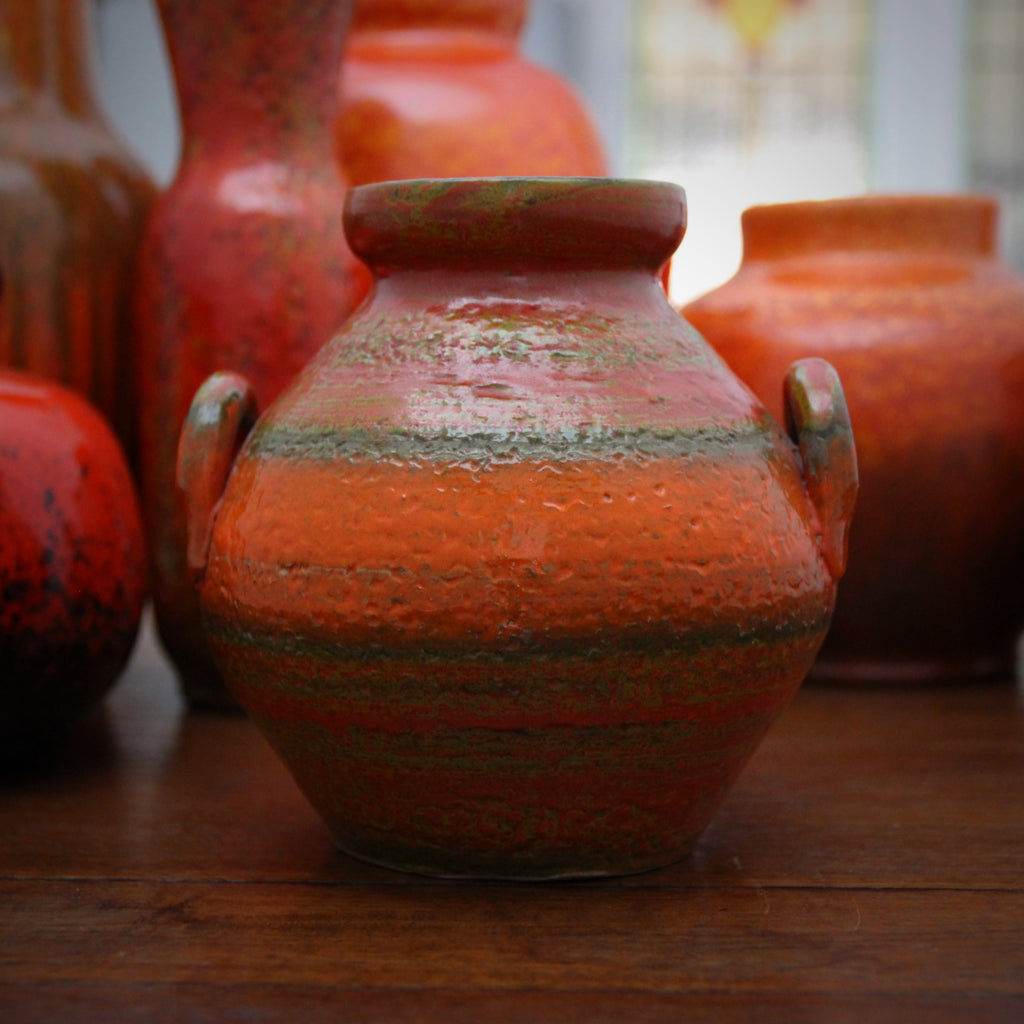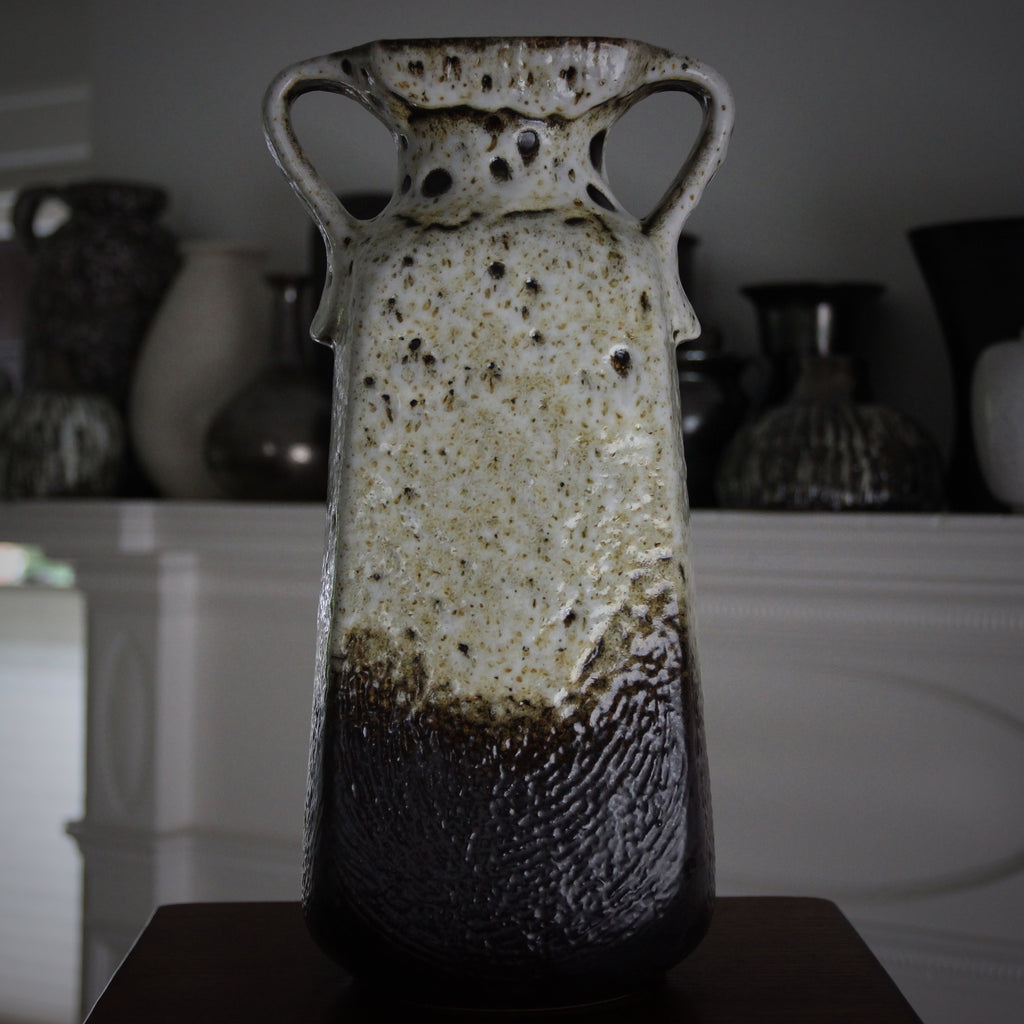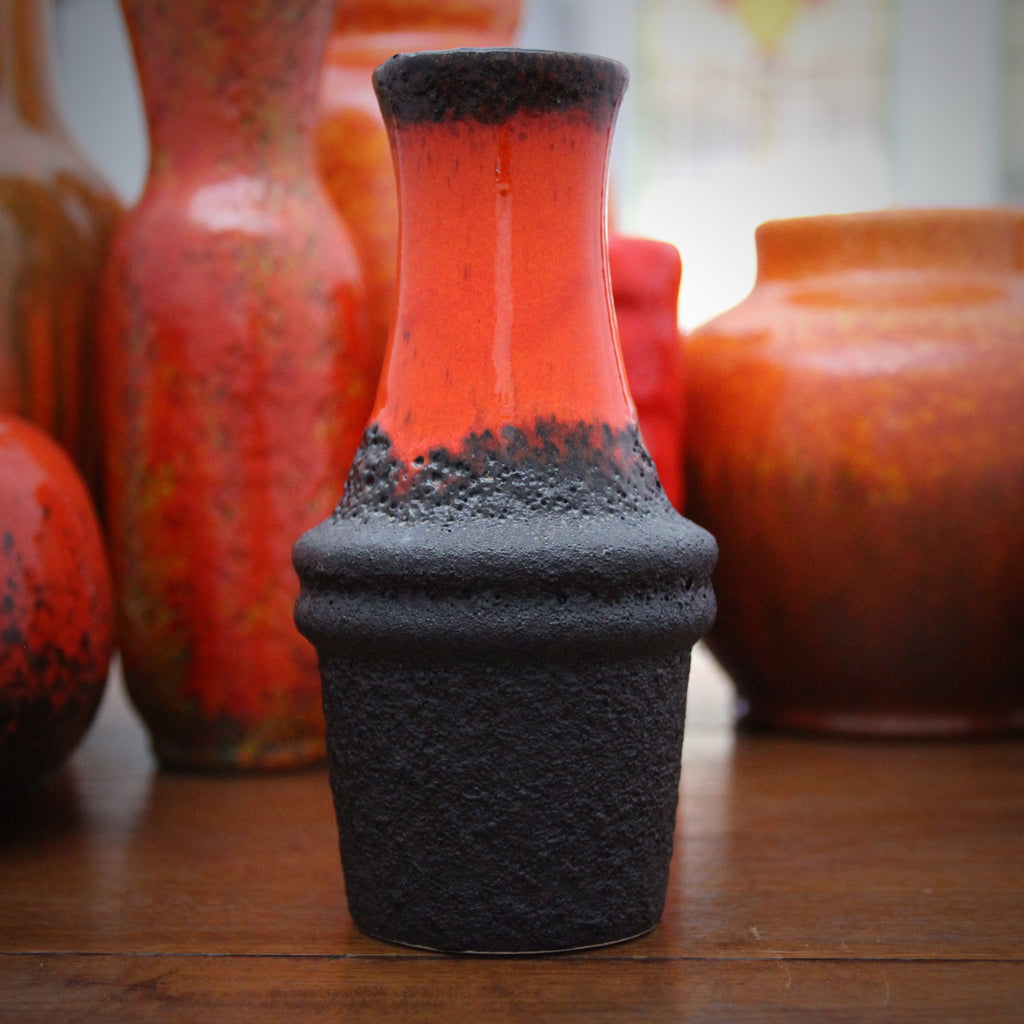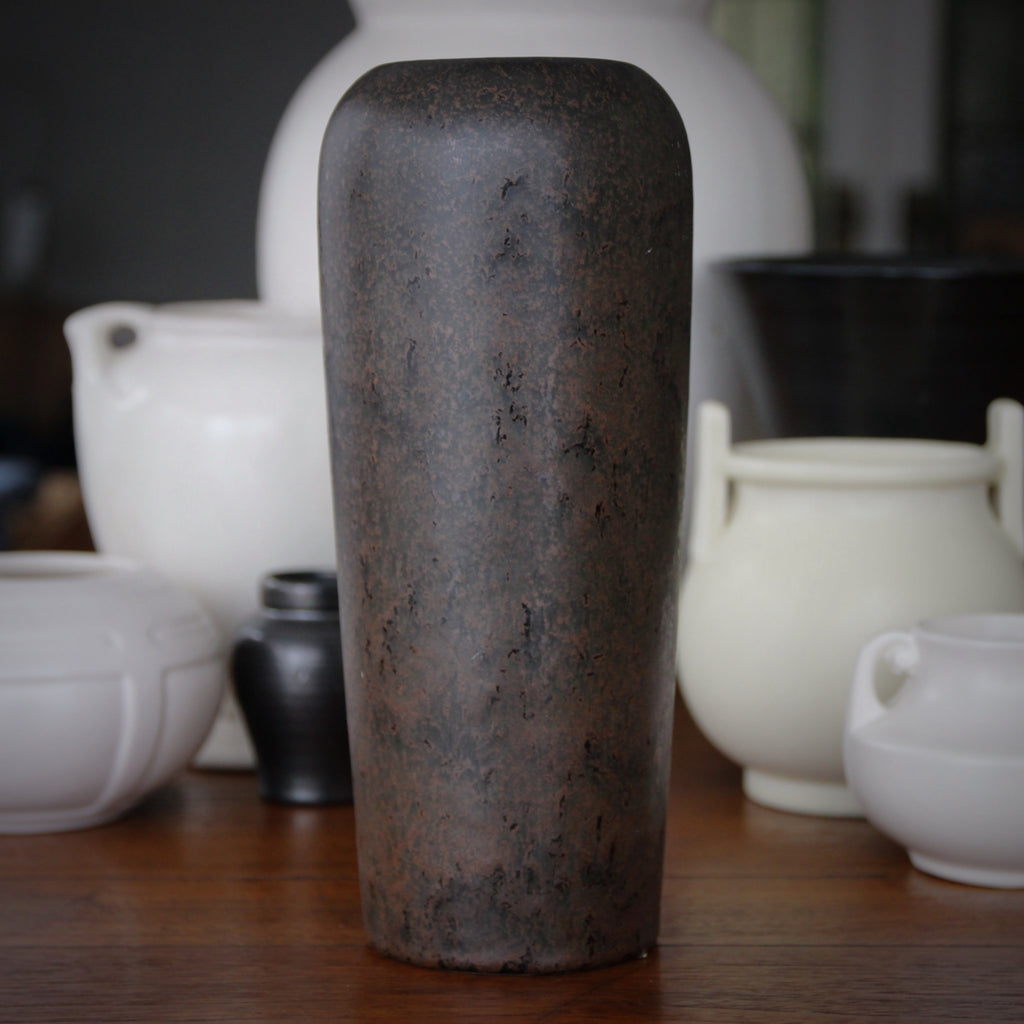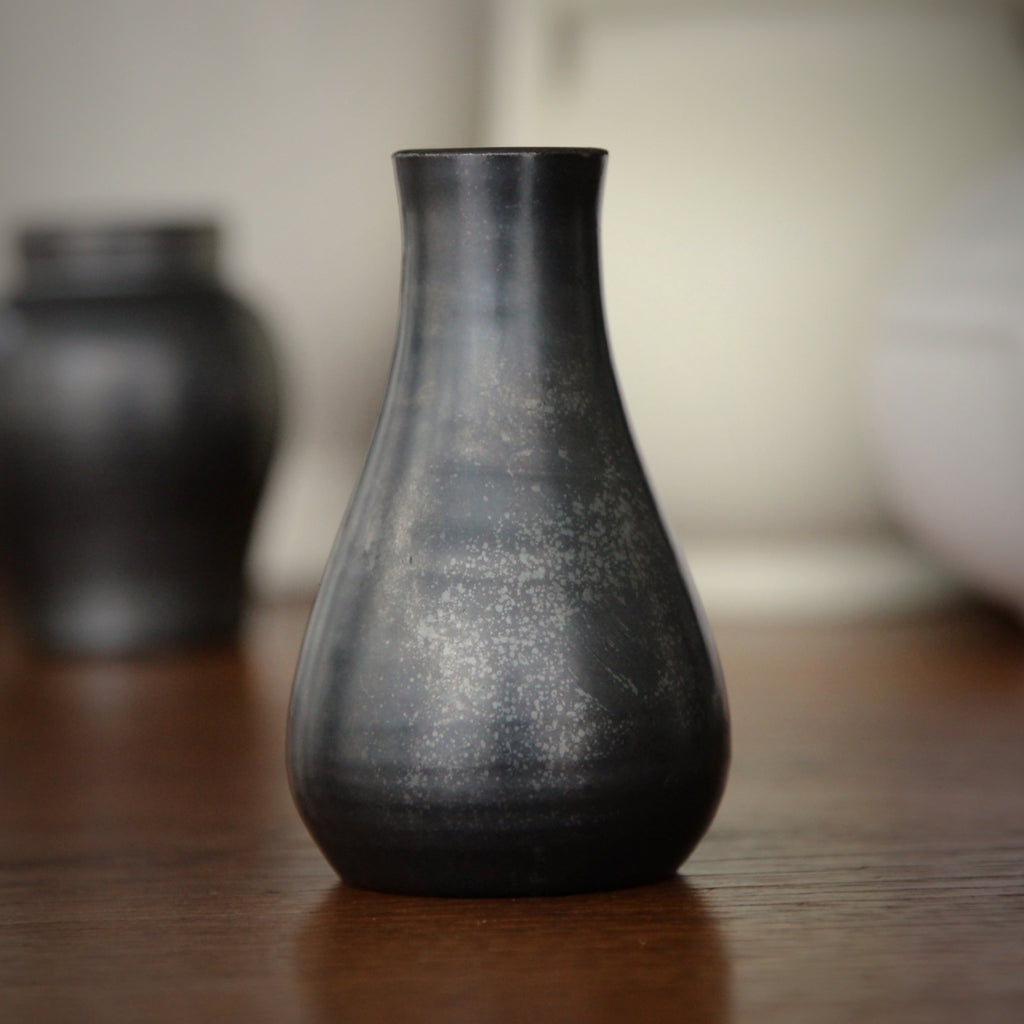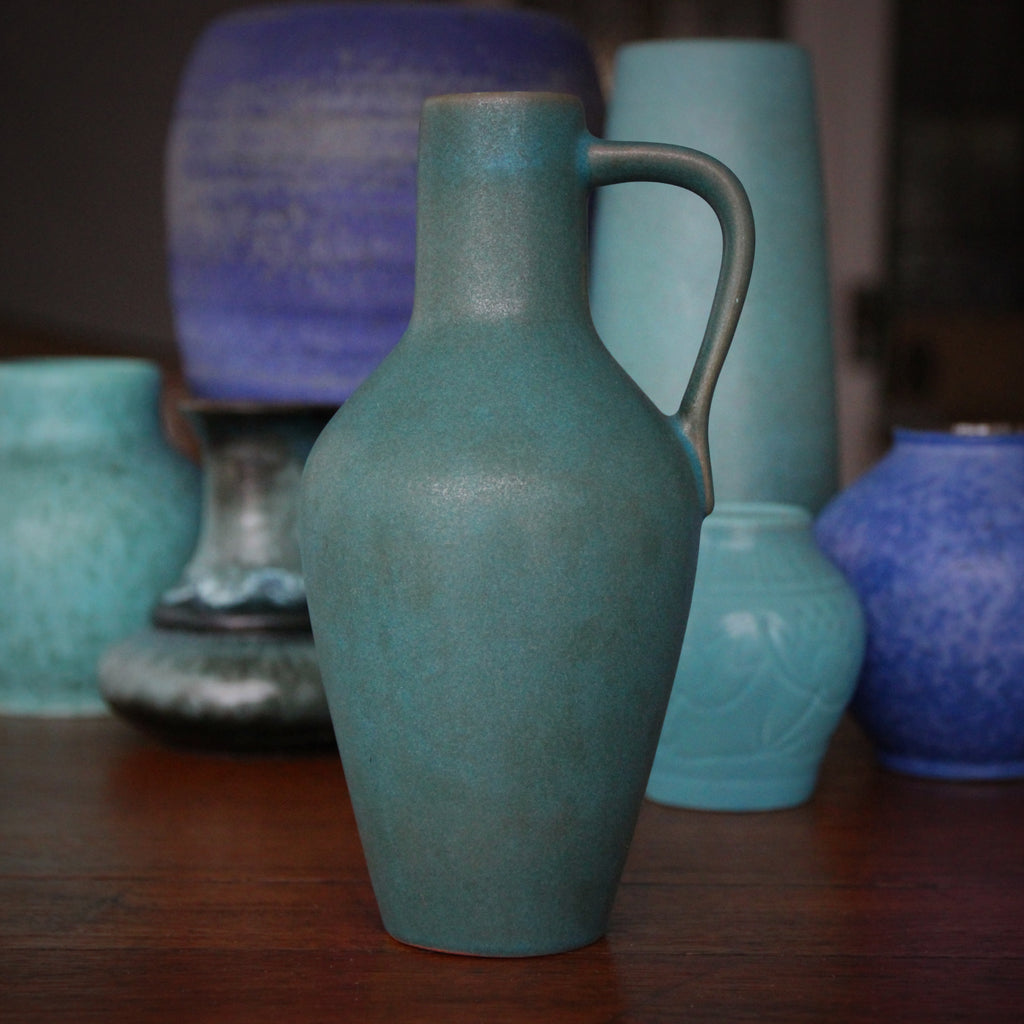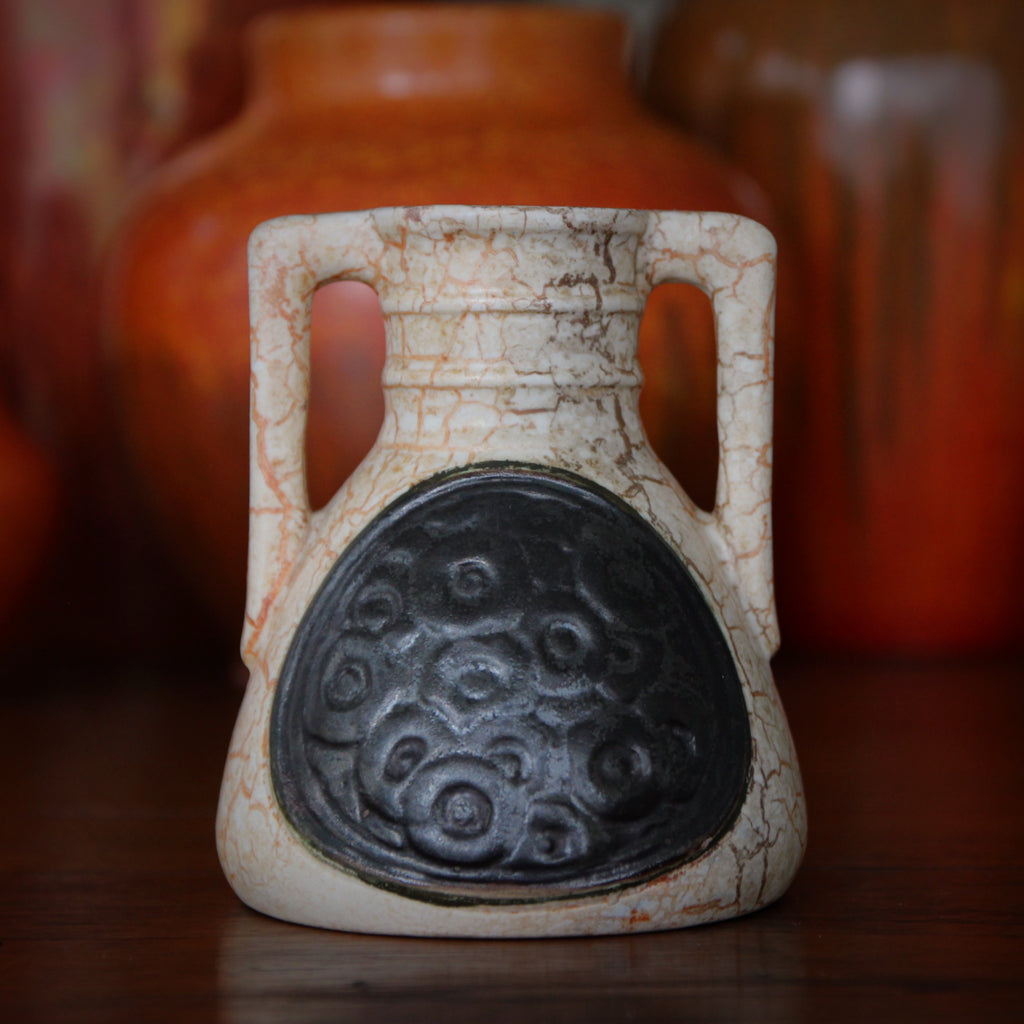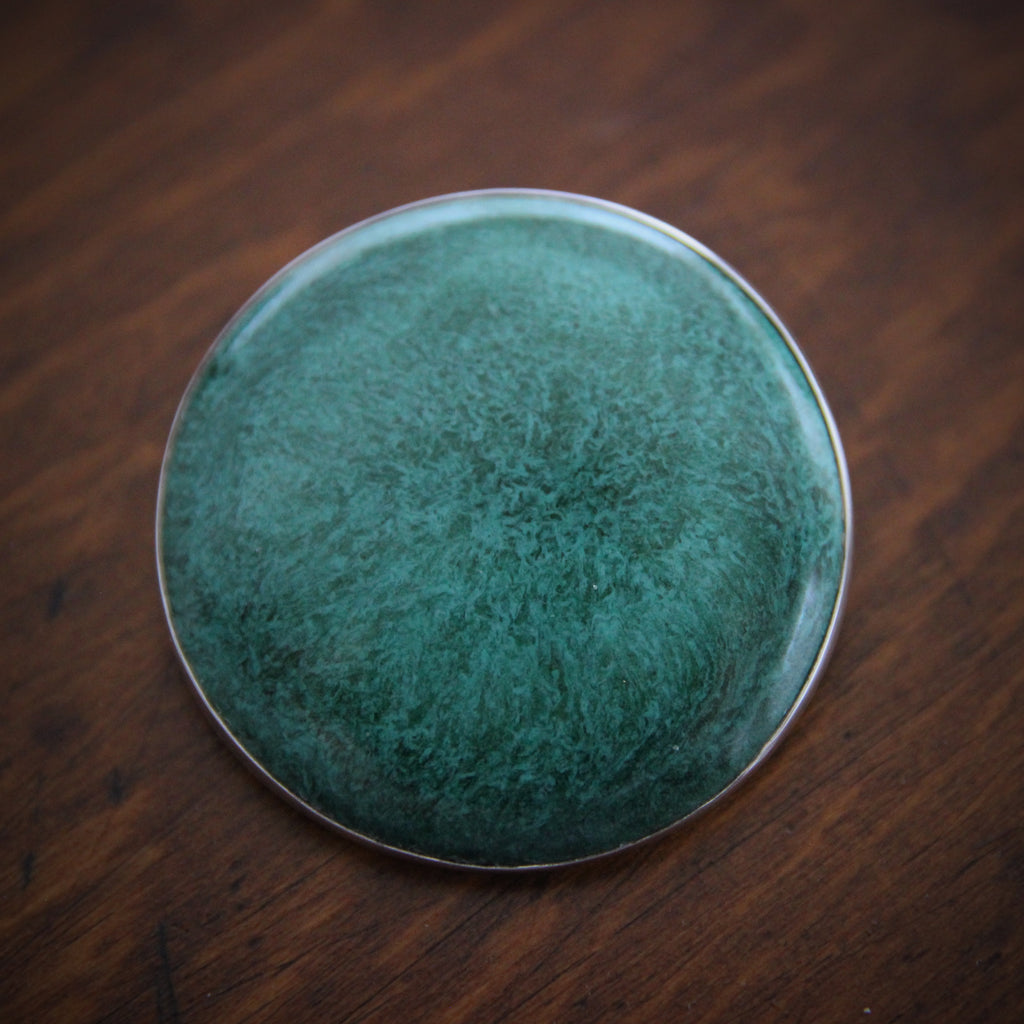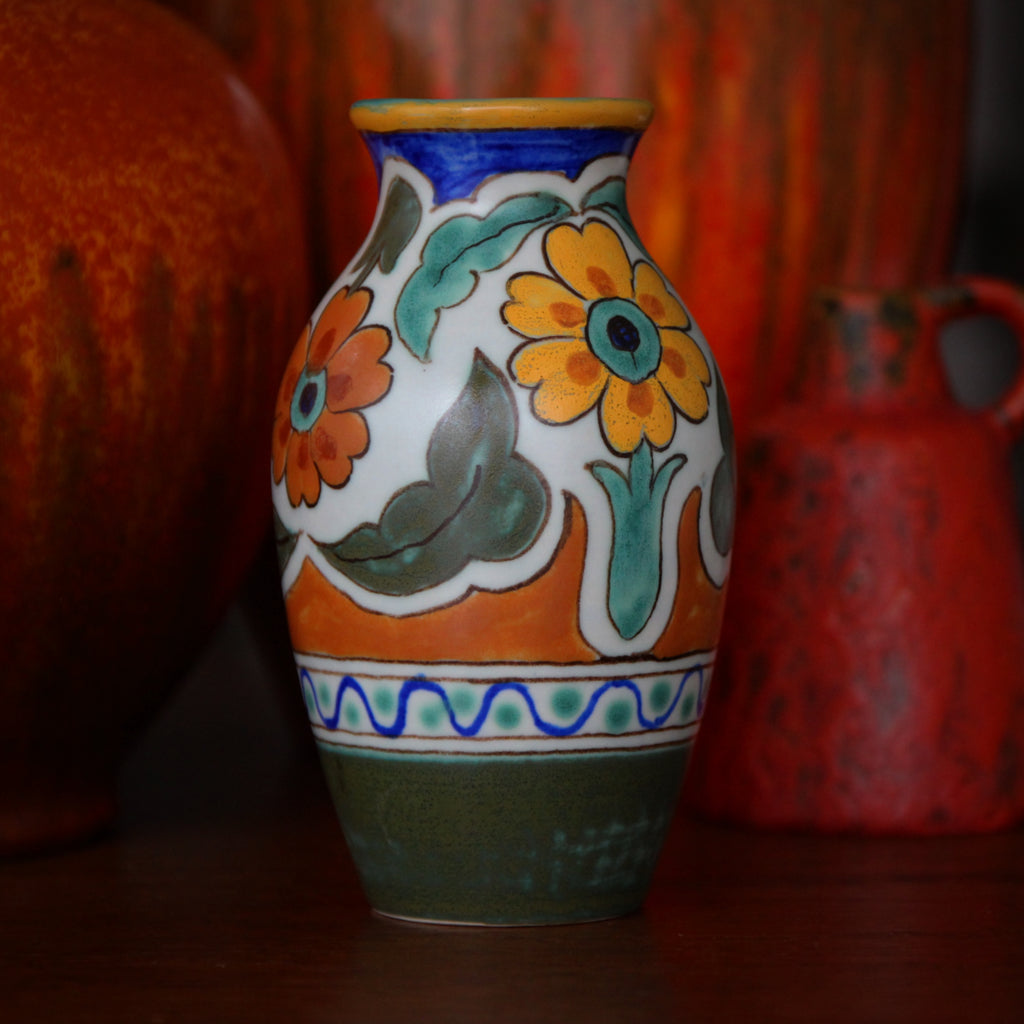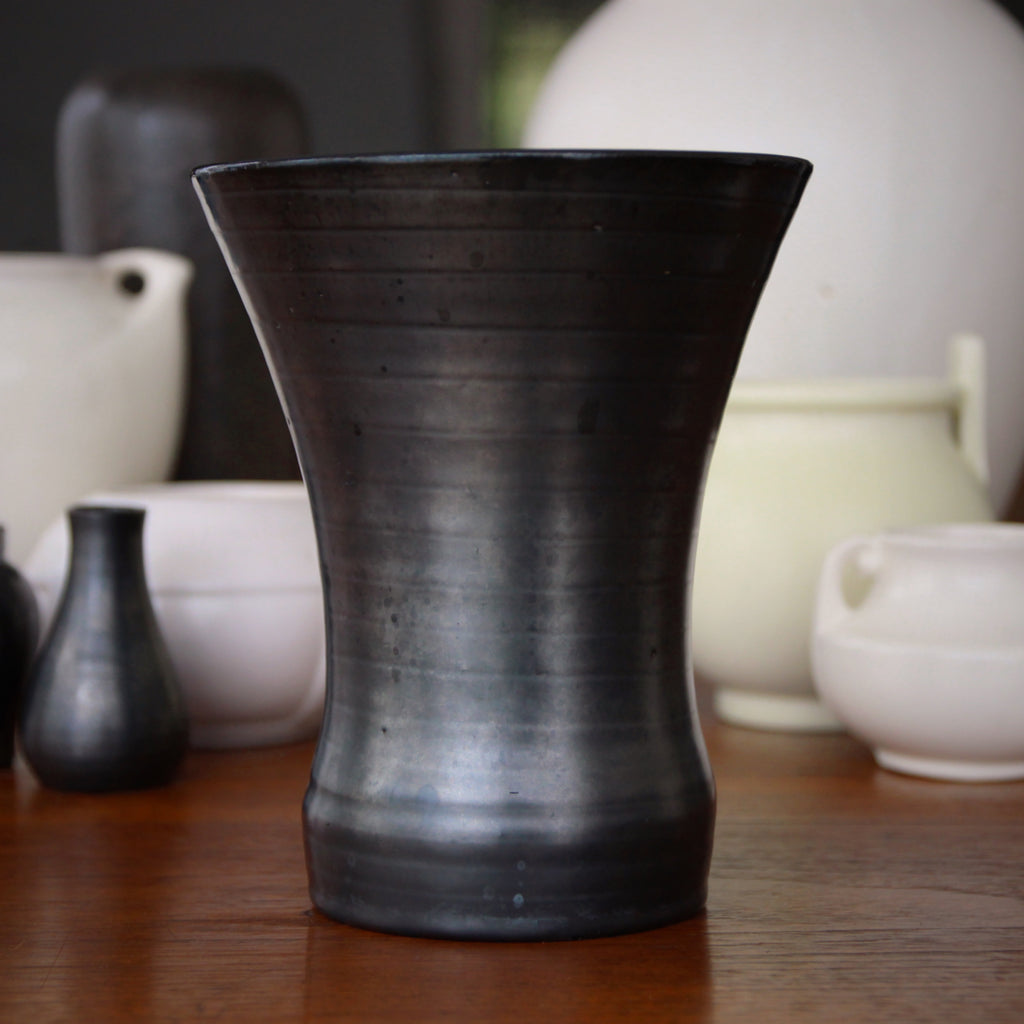JOURNAL — Art Pottery RSS
In recent days, the excitement about Apollo 11's fiftieth anniversary has turned my attention to Space—and all things "outer-spacey." Consequently, LEO Design's nice collection of (mostly) English Arts & Crafts ceramics with "otherworldly" iridescent gunmetal glazing ended-up catching my eye. Over the next several days, I'll be sharing a selection of them with you. This English Arts & Crafts flaring "trumpet" vase was hand-thrown and glazed with an iridescent metallic gunmetal glaze. It was crafted in Sussex by Dickerware in the 1910's or 1920's.. Click on the photo above to learn more about it. Though our Greenwich Village store is now permanently closed, LEO Design is still alive and well! Please visit our on-line store where we continue to sell...
Approaching the Moon
Fifty years ago today, our three astronaut-heroes—Neil Armstrong, Buzz Aldrin, and Michael Collins—had been flying toward the moon for three days. Now they were almost there. While we fete the bravery, skill, and intelligence of the three lunar astronauts, let's not forget about the incredible contributions of the earth-bound scientists, mathematicians, technicians and craftspeople who supported the mission from the ground—the 400,000 specialists who, similarly, lived, ate and breathed the Apollo 11 event. And, while the space trip and its preparation were important, we also have to recognize how important a "jump start" the mission gave to the civilian world of science and technology after splash-down. I began collecting "otherworldly" ceramics before I knew how to classify or describe them....
Ceramic Contradiction
Contradiction sometimes results in interesting aesthetics. Take this hand-thrown Danish Modernist vase made by Per Studio, c. 1960. The rough stoneware and the subtle glaze coloration make for a fairly understated piece. But look at the clean spiraling finger marks along the sides of the vase—which indicate a high degree of artisan control on the potter's wheel. And the tightly spiraled brushwork at the glazed top which creates an ombré effect of brown to white. While there's very little "bling" here, clearly the vase was crafted by a skilled artist with a trained hand. Please click on the photo above to learn more about this interesting piece. Though our Greenwich Village store is now permanently closed, LEO Design is still alive...
Bleecker Raton Mall
24 years ago today, I was on my (considerably younger) hands and knees, refinishing the old wooden floor boards of my soon-to-open LEO Design store at 413 Bleecker Street. It was a big leap for me—leaving a good job, newly-signed coop mortgage in-hand. My entire life was changing. In the ensuing (nearly) quarter century, many other things have changed, and yet, some things remain the same. Greenwich Village—and Bleecker Street in particular—changed enormously during my tenure. Once the province of one-off mom and pop businesses, Bleecker was soon to become a magnet for corporate-owned designer name chain stores. Sure they were hip, or at least they carefully marketed that image. But the international conglomerate Louis Vuitton/Möet Hennessy's first boutique augured an irreversible...
La Fête Nationale
Paris's "Bastille Saint-Antoine" was built (beginning in 1357) as a fortress to protect the Porte Saint-Antoine, a busy and important gate into the walled city. Before long, it became a location where kings would jail their enemies—people who opposed, contradicted or simply annoyed the monarch. Prisoners would be held on the whim of the king, without legal due process or right of appeal. Paris's seething masses soon began to view the Bastille as a despised symbol of monarchical absolutism. Besides prisoners, the Bastille was used to hold weapons and ammunition. Fast forward to 14 July 1789. Paris was hot—literally and figuratively. And revolutionaries were ready to eliminate the king, even if they had to give their lives in the process. The revolutionaries...
Sun Baked - part III
In the 15th Century, Europeans developed the "blast furnace" which could reach even higher temperatures and maintain them consistently. This allowed for the large scale production of metalworks, glassmaking, and the mass production of ceramic items—and marked the (very) early start of the Industrial Revolution (which would peak some 400 years later). With this advancement, ceramic objects no longer had to be a labor-intensive, luxury item. Indeed, certain ceramic objects could now be produced cheaply, making them practical for mundane, technical applications (like electrical insulators, first produced around 1850). In the second half of the Twentieth Century, after World War Two, highly sophisticated ceramics manufacturing contributed to specialized uses in electronics, medical science, automotives, aeronautics, and the space exploration industries. Even...
Sun Baked - part II
Yesterday we paused our ceramics history lesson around the year 9,000 BC—when ceramic food vessels were becoming widespread. At this time, earthenware tiles and bricks were also increasingly produced. Up to this point, all ceramics were made of stoneware and formed-by-hand. The invention of the wheel (for ceramics making!) around 3,500 BC, allowed ceramics vessels to be "thrown." Although still hand-crafted, the new technology allowed for faster production, more symmetrical uniformity, and more sophisticated execution. For the first time, ceramic vessels reached the level of an art form—and were further embellished with complex and pleasing decoration. The Chinese pioneered another ceramics advancement: the improvement of kilns which could reach higher temperatures and maintain those temperatures consistently. Around 600 AD, the Chinese began...
Sun Baked - part I
At some point in mankind's past, "ceramics" were invented—or, more likely, discovered. Some clever soul, walking alongside a hot, long-dried riverbed, noticed that the once-moist clay had hardened under the sun: "Hmmm. How could this be useful?" Initially, simple decorative (or religious) clay objects were formed and (probably) simply dried in the sun. The earliest discovered ceramic object is a statuette of a woman, made around 28,000 BC, unearthed in Brno, Czech Republic. Sculpted animals were also found from around this period. Utilitarian objects, like pots, have been discovered in China, dating to 18,000 BC. It is believed that such ceramics production then spread to Japan and Asian Russia. Around the year 9,000 BC, ceramic food containers (to hold grain...
Plummy Planter
English pottery maker Denby made this line of "Orientware" ceramics ware in the 1920's and 1930's. It was the tail end of the Arts & Crafts movement and meant to satisfy the British Middle Class taste for "all things Oriental." In this case, Denby understood "Orient" to mean the Middle East, not the Far East. Hence the Iznik blue glazing and the mysterious earthy plum finish. This vessel was made to hold a five-inch planter pot. Click on the photo above to learn more about it. Though our Greenwich Village store is now permanently closed, LEO Design is still alive and well! Please visit our on-line store where we continue to sell Handsome Gifts (www.LEOdesignNYC.com). We also can be found...
Riveting in Person
Some items are just so difficult to photograph well! This could be thanks to an uncompelling color. Or perhaps a small detail that cannot be captured well in a single product shot. Or, it could be the item's shine—the bane of a product photographer's workday. This piece ticks all three of these boxes. Yet, in person, this vase is sublime! Made by Barse-Backshamn in Denmark (c. 1960's), the vessel is dressed in a delicious ultra-rich, black coffee colored glaze. And the sweetest detail—three little ceramic rivets on each side—appear to "staple" the two strap handles to the side of the vase. Click on the photo above to learn more about it. Though our Greenwich Village store is now permanently closed, LEO Design is still...
Red Ahead - part III
Here's another piece by Rhein-Ruhr, made in West Germany in the 1960's or 1970's. It has that terrific—oh so Italian—red, popular on firetrucks, sports cars and stiletto heels. Click on the photo above to learn more about it.
Though our Greenwich Village store is now permanently closed, LEO Design is still alive and well! Please visit our on-line store where we continue to sell Handsome Gifts (www.LEOdesignNYC.com).
We also can be found in Pittsburgh's historic "Strip District" at Mahla & Co. Antiques (www.mahlaantiques.com) or in Canonsburg, Pennsylvania at The Antique Center of Strabane (www.antiquecenterofstrabane.com).
Or call to arrange to visit our Pittsburgh showroom (by private appointment only). 917-446-4248
Follow us on Instagram: "leodesignhandsomegifts"
Follow us on Facebook: "LEO Design - Handsome Gifts"
Red Ahead - part II
Where's the meeting point of red and orange? I call that place "Chinese Red." And, when the vermillion color decorates a little temple-form vase, it reaches its potential. This piece, made by Übelacker in the 1960's, is now on our website. Click on the photo above to learn more about it. Though our Greenwich Village store is now permanently closed, LEO Design is still alive and well! Please visit our on-line store where we continue to sell Handsome Gifts (www.LEOdesignNYC.com). We also can be found in Pittsburgh's historic "Strip District" at Mahla & Co. Antiques (www.mahlaantiques.com) or in Canonsburg, Pennsylvania at The Antique Center of Strabane (www.antiquecenterofstrabane.com). Or call to arrange to visit our Pittsburgh showroom (by private appointment only). 917-446-4248 Follow us on Instagram:...
Red Ahead - part I
With the Fourth of July just a few days behind us, I am still thinking of Red, White and Blue. Over the next few days, I'll share a couple of red pieces, currently in-store at LEO Design. This piece, though made in West Germany, seems to have a bit of Italian blood—evident in the rich, cherry red glazing. It was made by Rhein-Ruhr in the 1960's or 1970's and can be found in our on-line store. Click on the photo above to learn more about it. Though our Greenwich Village store is now permanently closed, LEO Design is still alive and well! Please visit our on-line store where we continue to sell Handsome Gifts (www.LEOdesignNYC.com). We also can be found in Pittsburgh's...
Secessionism
Secessionism is the Viennese interpretation of the broader Art Nouveau Movement. Like other Arts & Crafts "schools," Secessionism relied heavily on handcraft, stylized botanical motifs, and warm naturalism to create pleasing objets—items intended to enhance architecture, furniture, lighting and other elements of the decorative arts. And, like with L'Art Nouveau (aka: "The New Style"), Secessionism sought to "secede" from the prevailing, traditional norms of domestic and environmental design. Concurrent with this international new style—starting roughly around 1890 or 1900—was a growth spurt in the World's middle classes (especially in Western cities). As families moved from the peasantry (or labor class) into the middle class, they often sought to surround themselves with small luxuries (and had a little extra money in...
Art Deco's Long Tail
Unlike the Arts & Crafts movement—which was rather short-lived, and mostly killed-off by World War One—the Art Deco movement left a much longer and very influential mark on the history of aesthetic design. The "look" coalesced in the mid-Twenties, was put onto the back burner during World War Two, and came roaring back for parts of the 1940's and 1950's. While the Arts & Crafts school was labor-intensive, thus expensive, and a bit avant-garde in its day, Art Deco was well-suited to mass production techniques and could be applied to any manner of consumer product. Thus, the Art Deco style was found on everything from electric toasters, soda bottles, Bakelite radios, eye glasses, tea kettles, automobile fins—even lamp plugs and...
Jugendstil
The German name for Art Nouveau is Jugendstil—literally "The Youthful (or Young) Style." Like other movements under the Art Nouveau or Arts & Crafts umbrella, the Jugendstil references voluptuous, natural shapes, simple (beautiful) materials and lots of evident handcraft. This vase, made by Carl Fischer around 1900, boasts an organic glaze which drips down the softly-sloping sides of the vessel. Learn more about it by clicking on the photo above. Though our Greenwich Village store is now permanently closed, LEO Design is still alive and well! Please visit our on-line store where we continue to sell Handsome Gifts (www.LEOdesignNYC.com). We also can be found in Pittsburgh's historic "Strip District" at Mahla & Co. Antiques (www.mahlaantiques.com) or in Canonsburg, Pennsylvania at The Antique Center of...
Pre-Summer Blues - part VI
Summer afternoons bring to mind relaxed al fresco dinners—with their crisp white linen tablecloths juxtaposed to the ever-wild verdancy of a well-planted French garden. And no French dinner (or lunch) would be complete without a jug of table wine—such as the one shown above. Made by Gilbert Méténier in the 1910's, it exhibits the Gothic Revival variant of turn-of-the-century Art Nouveau, and is glazed with organic, dripping brown, blue and green glazes. Click on the photo above to learn more about this piece. Though our Greenwich Village store is now permanently closed, LEO Design is still alive and well! Please visit our on-line store where we continue to sell Handsome Gifts (www.LEOdesignNYC.com). We also can be found in Pittsburgh's historic "Strip District"...
Pre-Summer Blues - part V
Here's another example of a Denby "Orientware" English Arts & Crafts ceramic piece, made in the 1920's or 1930's. Like its siblings in the product line, it is finished with delicious Iznik Blue and Plum glazes, intending to bring an interpreted Eastern aesthetic to Western households. This piece might hold a small pot, a full (but short) handful of flowers, or several dozen lucky pencils on an architect's desk. Please click on the photo above to learn more about it. Though our Greenwich Village store is now permanently closed, LEO Design is still alive and well! Please visit our on-line store where we continue to sell Handsome Gifts (www.LEOdesignNYC.com). We also can be found in Pittsburgh's historic "Strip District" at Mahla...
Pre-Summer Blues - part IV
A constellation of rose glaze "freckles" spans the impossibly blue sky of this Rookwood Art Deco vase, made in Cincinnati in 1934. Imagine three abundant peony heads resting upon the incised shoulders of this handsome piece, made between the wars. Click upon the photo above to learn more about this piece. Though our Greenwich Village store is now permanently closed, LEO Design is still alive and well! Please visit our on-line store where we continue to sell Handsome Gifts (www.LEOdesignNYC.com). We also can be found in Pittsburgh's historic "Strip District" at Mahla & Co. Antiques (www.mahlaantiques.com) or in Canonsburg, Pennsylvania at The Antique Center of Strabane (www.antiquecenterofstrabane.com). Or call to arrange to visit our Pittsburgh showroom (by private appointment only). 917-446-4248 Follow us on Instagram:...
Pre-Summer Blues - part III
Variegated streaks of blue enliven this French Art Nouveau two-handled urn by Pierrefonds. Made around 1920, the classical form becomes modern with movement and color. Sensational anchoring a collection of blue ceramics, it has the gravitas to stand alone as a statement piece. Please click on the photo above to learn more about it. Though our Greenwich Village store is now permanently closed, LEO Design is still alive and well! Please visit our on-line store where we continue to sell Handsome Gifts (www.LEOdesignNYC.com). We also can be found in Pittsburgh's historic "Strip District" at Mahla & Co. Antiques (www.mahlaantiques.com) or in Canonsburg, Pennsylvania at The Antique Center of Strabane (www.antiquecenterofstrabane.com). Or call to arrange to visit our Pittsburgh showroom (by private appointment only). 917-446-4248 Follow...
Pre-Summer Blues - part II
Though it's only a touch, the blue on the rim of this French Art Nouveau vase still makes a strong statement. Made by Gilbert Méténier in the 1910's, this vase is the perfect size for a small flower arrangement or an extra special pencil cup. Click on the photo above to learn more about it. Though our Greenwich Village store is now permanently closed, LEO Design is still alive and well! Please visit our on-line store where we continue to sell Handsome Gifts (www.LEOdesignNYC.com). We also can be found in Pittsburgh's historic "Strip District" at Mahla & Co. Antiques (www.mahlaantiques.com) or in Canonsburg, Pennsylvania at The Antique Center of Strabane (www.antiquecenterofstrabane.com). Or call to arrange to visit our Pittsburgh showroom (by private appointment only). 917-446-4248...
Pre-Summer Blues - part I
As James Joyce aptly noted, "Summer" and "Afternoon" have always been "the two most beautiful words in the English language." Well, summer is four weeks away and I'm already dreaming of blue skies & blue seas. Over the next few days, we'll share a collection of ceramics that celebrate the up-coming season—naturally, in shades of blue. The English Arts & Crafts ceramic ashtray, shown above, was made in the 1920's by Denby for their "Orientware" line. Using Iznik Blue and plum glazes, "Orientware" attempted to capture exotic Eastern design—which was very popular in the West—for customers who could not afford to travel to Asia or invest in precious Oriental ceramics. Consider this piece as a handsome thank you gift for...
Eastern Inspiration - part III
We've been discussing "Aesthetic Adaptation," specifically the use of foreign design elements in another country's craft. But sometimes designers and craftspeople lift ideas from an earlier time in their own culture's past. One example happened during the Arts & Crafts period, when earlier Gothic elements were reinterpreted and utilized some 800 years later. Like with cross-cultural adaptations, the aesthetic needed to be modified and translated for a contemporary taste. The piece above is one of several in our collection by George Clewes. It was made during the late English Arts & Crafts period, around 1920. The "Indian Flame" decor is hand-painted in a sophisticated craft-like style. Click on the photo above to learn more about it. Though our Greenwich...
Eastern Inspiration - part II
"Aesthetic Adaptation" almost never involves precise replication. Sometimes just the spirit of the foreign aesthetic is utilized—or just certain specific elements are interpreted, while others are neglected. As such, a degree of "artistic interpretation" comes into play—a foreign aesthetic is "translated" for a new audience. Take the vase shown above. It was made in the 1920's by George Clewes (England) for a line he called "Chameleonware." The hand-painted flame-like design was an interpretation of an Indian aesthetic—perhaps from textile works or the coveted Indian miniature paintings from the Middle Ages. Click on the photo above to learn more about it. Though our Greenwich Village store is now permanently closed, LEO Design is still alive and well! Please visit our on-line...
Eastern Inspiration - part I
A recurring theme at LEO Design is my interest in "Aesthetic Adaptation"—when the artists and craftspeople of one country emulate the design aesthetic of another country's artists and craftspeople. In recent years, critics have labeled such "interpretations" as "Cultural Appropriation." I do not judge it so cynically. Through the years, I have purchased many beautiful objects that were inspired in one part of the world by the artisans in another part of the world. Most times, the catalyst for such an "appropriation" was a sincere admiration for the aesthetics, the craft, of the other time and place. But there was another compelling reason why these adaptations sometimes occurred: affordability. Ceramics from remote places—say, the Far East or the Middle East—were...
In Vino Veritas - part III
"It doesn't matter if the glass is half-empty or half-full—there is clearly room for more wine!" - Anonymous A corseted, "triple gourd" form ceramic wine jug is finished with sophisticated microcrystalline tan and olive drip glazes. Serve your guests their vin with élan using this handsome and unusual piece. Click on the photo above to learn more about it. Though our Greenwich Village store is now permanently closed, LEO Design is still alive and well! Please visit our on-line store where we continue to sell Handsome Gifts (www.LEOdesignNYC.com). We also can be found in Pittsburgh's historic "Strip District" at Mahla & Co. Antiques (www.mahlaantiques.com) or in Canonsburg, Pennsylvania at The Antique Center of Strabane (www.antiquecenterofstrabane.com). Or call to arrange to visit our Pittsburgh showroom (by...
In Vino Veritas - part II
"A meal without wine is called breakfast" - Anonymous Another handsome French Art Nouveau ceramic wine jug—perfect for your summer entertaining. It was made in the 1920's and you can learn more about it by clicking on the photo above. Though our Greenwich Village store is now permanently closed, LEO Design is still alive and well! Please visit our on-line store where we continue to sell Handsome Gifts (www.LEOdesignNYC.com). We also can be found in Pittsburgh's historic "Strip District" at Mahla & Co. Antiques (www.mahlaantiques.com) or in Canonsburg, Pennsylvania at The Antique Center of Strabane (www.antiquecenterofstrabane.com). Or call to arrange to visit our Pittsburgh showroom (by private appointment only). 917-446-4248 Follow us on Instagram: "leodesignhandsomegifts" Follow us on Facebook: "LEO Design - Handsome...
In Vino Veritas - part I
"This is one of the disadvantages of wine: it makes a man mistake words for thoughts" - Samuel Johnson Gothic "bosses" punctuate the perimeter of this pair of French Art Nouveau wine jugs made by Denbac, c. 1910's. An earthy, mottled tan finish is topped with an organic, dripping olive glaze. Wine jugs such as these were de rigueur on any French lunch or dinner table. Revive the tradition at your summer table al fresco. Click on the photo above to learn more about them. Though our Greenwich Village store is now permanently closed, LEO Design is still alive and well! Please visit our on-line store where we continue to sell Handsome Gifts (www.LEOdesignNYC.com). We also can be found...
Crystal Green
Pierrefonds, the French Art Nouveau ceramics workshop, really made a name for itself with its fascinating, effusive and spontaneous crystalline glazes. And, though LEO Design has been collecting these works for years (and many pieces will be found in our on-line store), never have we come across a verdant, Spring green glaze like the piece shown here. It is heavily crystallized and has an extremely dry "hand-feel." It's color is intriguing, sophisticated and uncommon—quite atypical of most Pierrefonds production. I have often wondered if Fulper (the American ceramics studio), which began producing sophisticated "artistic" glazes around the year 1910 (under the leadership of Martin Stangl), found inspiration in the French Art Nouveau wares made by Pierrefonds (which began this type of...
Countdown to Mother's Day - part VII
Here's a Mother's Day gift that will not soon be forgotten. Made in the year (and dated) 1912, this English Arts & Crafts globular vase is decorated with hand-painted "palmettes"—giving it a handsome Middle Eastern mien. It was made by Pilkington Royal Lancastrian and would take pride-of-place in nearly any Traditional, Arts & Crafts, Art Deco or Mid-Century Modern interior. Please click on the photo above to learn more about it. More Mother's Day gift ideas tomorrow... Though our Greenwich Village store is now permanently closed, LEO Design is still alive and well! Please visit our on-line store where we continue to sell Handsome Gifts (www.LEOdesignNYC.com). We also can be found in Pittsburgh's historic "Strip District" at Mahla & Co. Antiques (www.mahlaantiques.com) or in...
Countdown to Mother's Day - part VI
Spread a little sunshine your mother's way with this English Art Deco ceramic platter by Crown Ducal, c. 1930's. Hand-painted orange trees encircle the rim and offer a stylish, sunny way for mom to feed her brood. Click upon the photo above to learn more about this piece. More Mother's Day gift ideas tomorrow... Though our Greenwich Village store is now permanently closed, LEO Design is still alive and well! Please visit our on-line store where we continue to sell Handsome Gifts (www.LEOdesignNYC.com). We also can be found in Pittsburgh's historic "Strip District" at Mahla & Co. Antiques (www.mahlaantiques.com) or in Canonsburg, Pennsylvania at The Antique Center of Strabane (www.antiquecenterofstrabane.com). Or call to arrange to visit our Pittsburgh showroom (by private appointment only). 917-446-4248 Follow...
Countdown to Mother's Day - part V
This hand-painted beauty has "Mom" written all over it. Made in Gouda, Netherlands around 1910, it is decorated with handsome Art Nouveau graphics and tulip blossoms. Click on the photo above to learn more about it. More Mother's Day gift ideas tomorrow... Though our Greenwich Village store is now permanently closed, LEO Design is still alive and well! Please visit our on-line store where we continue to sell Handsome Gifts (www.LEOdesignNYC.com). We also can be found in Pittsburgh's historic "Strip District" at Mahla & Co. Antiques (www.mahlaantiques.com) or in Canonsburg, Pennsylvania at The Antique Center of Strabane (www.antiquecenterofstrabane.com). Or call to arrange to visit our Pittsburgh showroom (by private appointment only). 917-446-4248 Follow us on Instagram: "leodesignhandsomegifts" Follow us on Facebook: "LEO Design - Handsome...
Countdown to Mother's Day - part II
Why give Mom a vase of flowers when you can give her A Vase Of Flowers—with beautiful blossoms which will last another 123 years? This French Aesthetic Movement vase was made by Revernay and is dated 1896. Stylized, hand-painted dandelions (French for "tooth of the lion") encircle this heavy stoneware vessel. Learn more about it by clicking on the photo above. More Mother's Day gift ideas tomorrow... Though our Greenwich Village store is now permanently closed, LEO Design is still alive and well! Please visit our on-line store where we continue to sell Handsome Gifts (www.LEOdesignNYC.com). We also can be found in Pittsburgh's historic "Strip District" at Mahla & Co. Antiques (www.mahlaantiques.com) or in Canonsburg, Pennsylvania at The Antique Center of Strabane (www.antiquecenterofstrabane.com). Or call to...
Paul Dressler
Two of Paul Dressler's signature treatments is the use of mottled gunmetal glazes and a hand-incised "webbing" which gives the piece a "recovered archeological" look. Dressler was amongst the most important German Modernist ceramicists between the wars. To learn more about this vase, made in the 1960's, please click on the photo above. Though our Greenwich Village store is now permanently closed, LEO Design is still alive and well! Please visit our on-line store where we continue to sell Handsome Gifts (www.LEOdesignNYC.com). We also can be found in Pittsburgh's historic "Strip District" at Mahla & Co. Antiques (www.mahlaantiques.com) or in Canonsburg, Pennsylvania at The Antique Center of Strabane (www.antiquecenterofstrabane.com). Or call to arrange to visit our Pittsburgh showroom (by private appointment only). 917-446-4248 Follow us...
Vienna Calling - part II
German brothers Friedrich and Karel Rudolf Ditmar moved to Vienna in 1839 where they began selling metal oil lamps. Within a few years, they were manufacturing the lamps. They struck gold when they designed a lamp mechanism which better-moderated the oil flow to the wick—and soon this type of lamp fitting was selling worldwide. But the fashion in oil lamps was changing—favoring ceramic lamp bodies which offered more color, style and aesthetic options. So the brothers opened a ceramics workshop across the Czech border in a town called Znojmo. Their sole intention was to make ceramic bodies for oil lamps; in time, however, the workshop was producing porcelain dishes, majolica, steins and "sanitary ware" (sinks, water coolers, tubs). In 1919...
Vienna Calling - part I
Vienna was the crown of the expansive Austro-Hungarian Empire—and, as such, became the tastemaker for the rest of the realm. In turn-of-the-century Vienna, Secessionism (Austria's contribution to the larger Art Nouveau Movement) was all the rage, and the Movement spread throughout the rest of the Empire. But production of the decorative arts was not limited to Vienna (or Austria) alone; talented artisans in the "satellite" countries also contributed to the manufacture of Secessionist objets. The vase here, made in the mid-to-late Twenties, was made in (what was then) Czechoslovakia. The swirling "rosettes" on the handles could have come right off a Gustav Klimt painting. And the bronze gunmetal glazing gives the piece a suitable gravitas, like the handsome Secessionist architecture which still...
Glowing Red
This bowl won't let us forget that Iceland is a volcanic island-country. The boldly-textured "lava" around the outer walls still seems to be glowing red-hot! It was made by Glit and is a stunning counterpoint to a collection of larger, red ceramic pieces. Click on the photo above to learn more about it. Though our Greenwich Village store is now permanently closed, LEO Design is still alive and well! Please visit our on-line store where we continue to sell Handsome Gifts (www.LEOdesignNYC.com). We also can be found in Pittsburgh's historic "Strip District" at Mahla & Co. Antiques (www.mahlaantiques.com) or in Canonsburg, Pennsylvania at The Antique Center of Strabane (www.antiquecenterofstrabane.com). Or call to arrange to visit our Pittsburgh showroom (by private appointment only). 917-446-4248 Follow us...
Gorgeous Rose
Pink may be my least favorite color—at least within my living spaces. And, yet, I could not stop picking-up this pitcher when I discovered it. In truth, it's more of a "rose" than a "pink." And the glaze is so wonderfully curdled—fashioned by organic happenstance—that the color became almost secondary to my aesthetic appreciation. The piece was made by Otto Gerharz, under his own pottery label, Otto Keramik. Please click on the photo above to learn more about it. Postscript: As I type this, I glance-out upon my garden, surveying my labors of the last several, 65° days. I see dozens of plantings, many promising an abundance of blossoms—in several variations of the color . . . pink. Maybe I don't hate...
Minerva
I'm not sure what this Ceramano vase has to do with the Roman goddess, Minerva, but the design is named after her. It wears triangular "armor" over its tapering neck and a rich, curry glaze. Please click on the photo above to learn more about it. Minerva is the Roman goddess of wisdom, handicrafts, the arts, medicine, commerce, poetry and war. Over the years, her importance within the pantheon of Ancient Roman gods expanded—making her one of the top three Roman deities. Her Greek counterpart was Athena, and, like her, Minerva was famously chaste. A famous statue of Minerva was installed in the Temple of Vesta, the architectural remains of which can be seen today in the Roman Forum. This circular...
Crème Brûlée
How can something so simple—and unpretentious—as a crème brûlée be so utterly delightful. And who doesn't love making the first crack? I guess it's the purity, the simplicity—and the contrast of a crispy burnt topping with a creamy, cool vanilla custard. Heavenly! The piece above, made by Scheurich in the 1960's or 1970's, reminds me of a crackled, layered crème brûlée. Multiple glaze levels, probably all applied before firing, react differently to the heat. The top glaze crackles, curdles and spreads while the underglaze says mostly-intact, pooling just a little in the crevices of the top glaze. Find it on our website by clicking the photo above. Though our Greenwich Village store is now permanently closed, LEO Design is still alive...
Hand-Built Beauty
Though simple in form, this 10 inch hand-built vase is very handy anchoring a collection of ceramic vases, urns or bowls. It was made in Art Nouveau France (c. 1910) by Gilbert Méténier. The Nineteenth Century family pottery studio was run by Gilbert until the Germans began to take France—at which point he destroyed his moulds and closed-down the operation before the Nazis could take it. He and his family then disappeared; what became of them has not been widely known. Please click on the photo above to learn more about this piece. Though our Greenwich Village store is now permanently closed, LEO Design is still alive and well! Please visit our on-line store where we continue to sell Handsome...
Baked Clay
I've always been more intrigued by ceramic glazes than I have by their forms. Perhaps there's an inner-chemist within me, dying to open a ceramics studio. Thus, a new and unusual glaze will always catch my eye—like that upon this West German vase by Scheurich. A "burnt honey" glaze is splattered with a contrasting, yeast-like overglaze. The effect reminds me of a European baked treat; perhaps a pretzel or a loaf of bread. Please click on the photo above to learn more about it. Though our Greenwich Village store is now permanently closed, LEO Design is still alive and well! Please visit our on-line store where we continue to sell Handsome Gifts (www.LEOdesignNYC.com). We also can be found in Pittsburgh's historic...
French Accent
Here's a sweet piece, made in Art Nouveau France (c. 1910's). This little "cabinet vase" is dressed with flowing mustard, caramel and metallic pewter glazes. It would provide a wonderful (little) counterpoint to a collection of larger ceramics. It would likewise suit a vignette of metallic objets, lamps or sculpture. Please click on the photo above to learn more about it. Though our Greenwich Village store is now permanently closed, LEO Design is still alive and well! Please visit our on-line store where we continue to sell Handsome Gifts (www.LEOdesignNYC.com). We also can be found in Pittsburgh's historic "Strip District" at Mahla & Co. Antiques (www.mahlaantiques.com) or in Canonsburg, Pennsylvania at The Antique Center of Strabane (www.antiquecenterofstrabane.com). Or call to arrange to visit our Pittsburgh...
A Distant Moon
I have a fondness for interesting glazes—especially those which resemble distant moons or planets (real or imagined). This piece, made in West Germany by Tena Studios, has a pocked, high-texture surface, glazed with shades of blue, brown and grey. Click on the photo above to learn more about it. Though our Greenwich Village store is now permanently closed, LEO Design is still alive and well! Please visit our on-line store where we continue to sell Handsome Gifts (www.LEOdesignNYC.com). We also can be found in Pittsburgh's historic "Strip District" at Mahla & Co. Antiques (www.mahlaantiques.com) or in Canonsburg, Pennsylvania at The Antique Center of Strabane (www.antiquecenterofstrabane.com). Or call to arrange to visit our Pittsburgh showroom (by private appointment only). 917-446-4248 Follow us on Instagram: "leodesignhandsomegifts" Follow...
Pont des Vernes
In the late Eighteenth Century, Frenchman Pierre Langeron was commissioned to dig a canal in Pouilloux—located about two-thirds of the way between Paris and Lyon. While excavating, he discovered a high-quality white clay. By 1818, Langeron had opened a ceramics workshop near the bridge ("pont"), an important local landmark. Over the years, he (and his family) expanded the operation, starting with basic "utilitarian ware" (like hot water bottles) and adding decorative objects in time. The company, eventually named Pont des Vernes, continued from 1818 through World War Two, eventually closing-down in 1957. The vase above, made around 1910, boasts an exquisitely tapered neck and blue and tan glazes which drip down its sides. Learn more about it by clicking on...
Beautiful Blue
Every now and then, I'd see a customer silently perusing the boxes, urns and covered bowls in the shop—and, when asked, they would sheepishly admit that they were seeking a vessel into which they could inter a beloved pet's cremated remains. I would assure them that this was nothing to feel awkward about—and that, in fact, I had helped several customers select a repository for their larger loved ones as well. We would always look for something dignified, properly-sized, and aesthetically pleasing. Sometimes the piece even suited the physical or intangible characteristics of the deceased—a Celtic carved wooden box for a Scotsman, a floral motif to suit a gardener, or a Viennese hand-tooled brass box to suit an Austrian. This French...
Gouda You Do? - part III
Let's end our little parade of Gouda vases with this diminutive "cabinet" vase, made in the 1920's or 1930's. It is hand-painted with an unusual mustard-yellow glaze—punctuated with green, cobalt and burnt orange coloration. Click on the photo above to learn more about it. Though our Greenwich Village store is now permanently closed, LEO Design is still alive and well! Please visit our on-line store where we continue to sell Handsome Gifts (www.LEOdesignNYC.com). We also can be found in Pittsburgh's historic "Strip District" at Mahla & Co. Antiques (www.mahlaantiques.com) or in Canonsburg, Pennsylvania at The Antique Center of Strabane (www.antiquecenterofstrabane.com). Or call to arrange to visit our Pittsburgh showroom (by private appointment only). 917-446-4248 Follow us on Instagram: "leodesignhandsomegifts" Follow us on Facebook: "LEO Design -...
Gouda You Do? - part II
Here's another Gouda vase: a two-handled design, hand-painted with stylized botanicals and serpentine graphics. It is dated February 1921. "Gouda," by the way, is pronounced "How-dah" (not Goo-dah). Remember that the next time you buy a piece of Dutch ceramics. Or cheese. Please click on the photo above to learn more about this piece. Though our Greenwich Village store is now permanently closed, LEO Design is still alive and well! Please visit our on-line store where we continue to sell Handsome Gifts (www.LEOdesignNYC.com). We also can be found in Pittsburgh's historic "Strip District" at Mahla & Co. Antiques (www.mahlaantiques.com) or in Canonsburg, Pennsylvania at The Antique Center of Strabane (www.antiquecenterofstrabane.com). Or call to arrange to visit our Pittsburgh showroom (by private appointment only). 917-446-4248 Follow...
Gouda You Do? - part I
Gouda, in the Netherlands, is known for two things: cheese and hand-painted ceramics. Three things are were needed to establish a successful "pottery town": clay, a fuel source for the kilns (in this case, peat), and an easy means of transporting the finished goods away from the factories (in this case, canals and waterways). This piece, made in the 1920's or 1930's, is hand-painted wth a wreath of autumnal leaves which rests on the vessel's shoulders. Please click upon the photo above to learn more about it. Though our Greenwich Village store is now permanently closed, LEO Design is still alive and well! Please visit our on-line store where we continue to sell Handsome Gifts (www.LEOdesignNYC.com). We also can be found...
Earthy Greens
As the weather crosses the 45° mark I begin to venture-out into my garden. Having lived for three-plus decades in apartments, I'd have never guessed how much I like working in my little patch of nature. Right now it's (very) early Spring, the time to clean-up: collecting twigs, rearranging the stones, pulling the early weeds. And, naturally, planning what I'd like to do to keep prodding my garden in a particular aesthetic direction. The ground provides a certain "squishy" sensation at this time of year—and an earthy, mossy smell accompanies it. I find it intoxicating. The muddy blend of green and brown is so satisfying to me. Perhaps this explains my long-term affection for green ceramics—especially earthy, organic, natural greens, like...
Wine-Country
Lunch or dinner, a jug or bottle of good wine is always on the French table. And what I admire about the French attitude towards wine is that "it's no big deal"—just one part of a simple, well-considered meal. Americans tend to fetishize wine—and its accoutrements—employing long-stemmed, obscenely over-sized crystal goblets, perhaps a different shape for different varieties of grape. In France, a good (though not costly) table wine is served in simple glass tumblers—another example of France's practical relationship with vin. Shown here, a late Art Nouveau wine jug made by Denbac in the 1920s. A "pinecone" bas relief is finished with a microcrystalline brown glaze, topped with a dripping dose of caramel. A piece like this might have sat...
One More Taste
Here's another piece of Denby English Arts & Crafts "Orientware" with a bamboo-inspired cylindrical vase form. Like its line mates, it has a unique plum overglaze and an Iznik blue undercolor. Click on the photo above to learn more about it.
Though our Greenwich Village store is now permanently closed, LEO Design is still alive and well! Please visit our on-line store where we continue to sell Handsome Gifts (www.LEOdesignNYC.com).
We also can be found in Pittsburgh's historic "Strip District" at Mahla & Co. Antiques (www.mahlaantiques.com) or in Canonsburg, Pennsylvania at The Antique Center of Strabane (www.antiquecenterofstrabane.com).
Or call to arrange to visit our Pittsburgh showroom (by private appointment only). 917-446-4248
Follow us on Instagram: "leodesignhandsomegifts"
Follow us on Facebook: "LEO Design - Handsome Gifts"
A Taste of the Orient
The West has long had a fascination with "The East"—and, I suppose, the East has had a reciprocal enthusiasm. Perhaps its a human interest in things that are new, exotic, different or rare. While some people accuse the West of "cultural appropriation," I view it as curiosity and fascination with "the greener grass" across the fence. Since the 1600's, wealthy Europeans have been buying and collecting Asian objets. Additionally, the West has tried (with greater or lesser success) to emulate Asian design and figure-out their production techniques—especially in the field of ceramics. At times, the Western artists would simply copy Asian items. At other times, they would "adapt" Asian designs, "re-interpreting" them for a Western taste. While these efforts may have resulted in...
And Even More Spring
Just one more glimpse of Spring: an Art Deco Thirties fan-form vase by Van Briggle. Made in Colorado Springs, Colorado, it is clearly hand-crafted (compare the slightly differing handles) and is finished with a graduated ombré glaze of aqua and blue. Perfect holding flowers, standing alone, or punctuating a larger collection of vases, plates and bowls. Please click on the photo above to learn more about it. Though our Greenwich Village store is now permanently closed, LEO Design is still alive and well! Please visit our on-line store where we continue to sell Handsome Gifts (www.LEOdesignNYC.com). We also can be found in Pittsburgh's historic "Strip District" at Mahla & Co. Antiques (www.mahlaantiques.com) or in Canonsburg, Pennsylvania at The Antique Center of Strabane (www.antiquecenterofstrabane.com). Or call to...
And a Little More Spring
Here's a bit more spring—for those looking-forward to the season. This Roseville Art Deco fan-form vase was made around 1928. It's fitted with "Moderne" botanical handles and is finished with a dappled aqua and grey glazing. Imagine it with a bouquet of white flowers—or bounteous heads of hydrangea, come Summer. Please click on the photo above to learn more about it. Though our Greenwich Village store is now permanently closed, LEO Design is still alive and well! Please visit our on-line store where we continue to sell Handsome Gifts (www.LEOdesignNYC.com). We also can be found in Pittsburgh's historic "Strip District" at Mahla & Co. Antiques (www.mahlaantiques.com) or in Canonsburg, Pennsylvania at The Antique Center of Strabane (www.antiquecenterofstrabane.com). Or call to arrange to visit our Pittsburgh...
Welcome, Spring!
Spring springs today—at 5:58 pm, Eastern Time! It's the Spring (or "Vernal") Equinox, a word which means "Equal Night." It's the date (and time) when day and night are exactly the same length. From this point forward, the days will be longer than the nights (that is, until the Autumnal Equinox on 23 September). We will also be treated to a concurrent full moon—and a "Super Moon" at that. Slightly closer to the Earth, the full moon will appear larger and brighter than usual. The last time we enjoyed a full moon during the Vernal Equinox was 38 years ago (20 March 1981—and I was a Senior in High School). This Art Deco vase, made by Stangl in the 1930's,...
Wearing of the Green
It's a great day for the Irish! While I've always known that I am part Irish, every six months (or so), 23 & Me re-distributes my ethnic proportions (which today stands at 63.5% Irish). I'm proud of my heritage (not just the Irish part) and have not forgotten the desperate circumstances which compelled three of my grandparents to leave their homelands. I'm also proud of my birth country—especially when she acknowledges (and celebrates) the immigrants who have chosen to become Americans (now and in the past). I like to remind myself that almost no one immigrates to America when everything is great back home. On the contrary, people have always come to America for a better life. There was no brass band...
Silhouette Perfection
Don't let the simplicity of this Rookwood two-handled pot belie the complexity of its inspiration. It's an Arts & Crafts piece (dated 1915), though one can see just a trace of Art Deco, still distant on the horizon. A band of Celtic bas relief rests on the sloping shoulder of the piece. And the perfectly-formed silhouette—from the exquisitely delicate foot to its crisply-sculpted handles—reveals a touch of Ancient Egyptian inspiration. To me, those influences add-up to silhouette perfection. Please click on the photo above to learn more about it. Though our Greenwich Village store is now permanently closed, LEO Design is still alive and well! Please visit our on-line store where we continue to sell Handsome Gifts (www.LEOdesignNYC.com). We also can...
Desert Swirl
The swirls of glaze which spiral down the sides of this Jasba Modernist pitcher remind me of a sun-bleached desert landscape. Mustard, caramel and white provide a warm, daytime effect—like that of a high-noon sun. Though the desert is not my invigorating environment, I find this piece—and its wonderful coloration—to be cheerful and optimistic. Click on the photo above to learn more about it. Though our Greenwich Village store is now permanently closed, LEO Design is still alive and well! Please visit our on-line store where we continue to sell Handsome Gifts (www.LEOdesignNYC.com). We also can be found in Pittsburgh's historic "Strip District" at Mahla & Co. Antiques (www.mahlaantiques.com) or in Canonsburg, Pennsylvania at The Antique Center of Strabane (www.antiquecenterofstrabane.com). Or call to arrange to...
Aesthetic Discord
Rarely does one associated hammering with ceramics. Which makes this German Modernist vase, made by Fohr in the 1960's or 1970's, so unusual. The appearance of all-over planishing is reminiscent of a hand-hammered brass or copper vessel. To top things off, the piece is then glazed in a rich caramel glaze—which drips down the sides and pools within the "hammer-mark" crevices. Click on the photo above to learn more about it. Though our Greenwich Village store is now permanently closed, LEO Design is still alive and well! Please visit our on-line store where we continue to sell Handsome Gifts (www.LEOdesignNYC.com). We also can be found in Pittsburgh's historic "Strip District" at Mahla & Co. Antiques (www.mahlaantiques.com) or in Canonsburg, Pennsylvania at The Antique Center...
Ancient Allure
Lidded ceramic pots always take me back to the Ancient World. I think of spices, incense and precious ointments—contained and, perhaps, dignified in a beautiful covered jar. This one, made in Art Nouveau France, is decorated with sculptural botanical swirls, perhaps hanks of pine needles. It is finished with an organic dripping glaze in caramel, rust and brown—lifted by the light sparkle of a gold dust glaze. Please click on the photo above to learn more about this piece. Though our Greenwich Village store is now permanently closed, LEO Design is still alive and well! Please visit our on-line store where we continue to sell Handsome Gifts (www.LEOdesignNYC.com). We also can be found in Pittsburgh's historic "Strip District" at Mahla &...
Perfect Form
This hearty egg-form vase—reminiscent of an ancient Egyptian "Canopic Jar"—was hand-made in Mid-Century England. Its perfect shape is softened with a dappled, multiple blue glaze. And the classic shape makes it a perfect accent in nearly any period decorating scheme—from Victorian to Mid-Century Modern. Click on the photo above to learn more about it. Though our Greenwich Village store is now permanently closed, LEO Design is still alive and well! Please visit our on-line store where we continue to sell Handsome Gifts (www.LEOdesignNYC.com). We also can be found in Pittsburgh's historic "Strip District" at Mahla & Co. Antiques (www.mahlaantiques.com) or in Canonsburg, Pennsylvania at The Antique Center of Strabane (www.antiquecenterofstrabane.com). Or call to arrange to visit our Pittsburgh showroom (by private appointment only). 917-446-4248 Follow...
Midnight/Blue
Buying "Studio Ceramics"—that is, those vases, plates and bowls which were handmade in a small artist-run workshop—is an interesting endeavor. First of all, one almost always must buy with his eye and buy with his taste. Because the makers are usually a mystery, one needs to trust his senses when selecting such a piece. Attracted, as I am, to glazes, my evaluation of studio pottery always begins with the color and finish. I also look for tell-tale signs of handwork—like the spiraling finger marks that indicate a piece had been hand-thrown. Substantial weight is a favorite feature and I like to see exposed areas (usually on the bottom) which reveal a chunky, earthy stoneware clay. The piece above, made somewhere...
Fat Tuesday!
It's Mardi Gras—translated "Fat Tuesday"—the final day before Lent. For Christians, Lent is a period of prayer, fasting and abstinence in preparation of Easter some 40 days later. And Mardi Gras is a day (sometimes a week) of celebration before the abstemiousness begins—a time to use up all the fat in the larder (not to mention the chocolate and other sweets). The pitcher, above, is "fat" in every way. It's heavy. It is fitted with a thick, strap-like handle. And it is dressed in a weighty dripping-rust glaze. Click on the photo above to learn more about it. Though our Greenwich Village store is now permanently closed, LEO Design is still alive and well! Please visit our on-line store where...
Czech, Please.
While Vienna was the artistic heart of the Austro-Hungarian Empire, Czechoslovakia might be considered the Empire's glass and ceramics workshop. This "Amphora" piece—an intriguing juxtaposition of bone-dry tan glazing and luscious hand-painted cabochons—was made in Czechoslovakia but was following the Viennese trend, au courant. Click on the photo above to learn more about it. Though our Greenwich Village store is now permanently closed, LEO Design is still alive and well! Please visit our on-line store where we continue to sell Handsome Gifts (www.LEOdesignNYC.com). We also can be found in Pittsburgh's historic "Strip District" at Mahla & Co. Antiques (www.mahlaantiques.com) or in Canonsburg, Pennsylvania at The Antique Center of Strabane (www.antiquecenterofstrabane.com). Or call to arrange to visit our Pittsburgh showroom (by private appointment only). 917-446-4248 Follow...
Danish Farrier
Every few decades (at least in the past), artists and designers would remember and celebrate "The Workingman"—those men and women who labor physically with their hands and bodies. Think of the French painter, Jean-François Millet, with his paintings of peasants reaping grain in the field. Or the pair of Art Deco limestone sculptures by Michael Lantz which grace the Federal Trade Commission building in Washington, DC. Similarly, the 1960's and 1970's enjoyed a revived appreciation of handcraft—and the people who executed it. Danish Modernist artist Karl Otto Johansen created a series of "tradesmen" plaques for Bing & Grøndahl around 1970. This example shows a farrier—a blacksmith who shoes horses—dressed in a leather apron, hammering furiously upon his anvil. The piece includes a...
Danish Plumber
A plumber—dressed in his blue jumpsuit—strains against his wrench on this Danish Modernist stoneware plaque by Karl Otto Johansen for Bing & Grøndahl. It was made around 1970 and includes a metal eyelet (on back) with which it can be hung on a nail. Click on the photo above to learn more about it. Though our Greenwich Village store is now permanently closed, LEO Design is still alive and well! Please visit our on-line store where we continue to sell Handsome Gifts (www.LEOdesignNYC.com). We also can be found in Pittsburgh's historic "Strip District" at Mahla & Co. Antiques (www.mahlaantiques.com) or in Canonsburg, Pennsylvania at The Antique Center of Strabane (www.antiquecenterofstrabane.com). Or call to arrange to visit our Pittsburgh showroom (by private appointment only). 917-446-4248 Follow...
Welcome, March!
Welcome, March—and its birthstone, the Aquamarine. Though not an aquamarine, I admit, this vase is the closest (new) piece I have that resembles the March gemstone's vivid color. Aquamarine is a variant of the stone called Beryl (a family which also includes Emeralds). Although Beryl is naturally colorless, the "impurities" within imbue various colors to the gemstone—green, blue, yellow, white and red (the rarest). Aquamarines (and other Beryl variants) are mined in Brazil, Columbia, Sri Lanka, Africa & Madagascar, the Russian Urals, and in the American West. Once believed to be the "treasure of mermaids," they were carried by sailors as a good luck talisman. They are also considered the stone of eternal youth & happiness and are believed to...
Modern Orange - part III
An earthy combination of textured "orange peel" glazing curdles around an unexpectedly complimentary grey counter-finish. Such a spontaneous and organic glaze combination provides stark counterpoint to the otherwise minimalist cylindrical vase, made in the 1960's or 1970's. Please click on the photo above to learn more about it.
LEO Design's Greenwich Village store is now permanently closed. While we contemplate our next shop location, please visit our on-line store which continues to operate (www.LEOdesignNYC.com).
Follow us on Instagram: "leodesignhandsomegifts"
Follow us on Facebook: "LEO Design - Handsome Gifts"
Modern Orange - part II
Though a made a couple of decades before the "Mid-Century," this English Art Deco vase is nevertheless progressively Modern. The simple ball-form vase is sculpted with softly rippling shoulder ridges—sending a strong Modernist signal. It's finished with a mottled glaze of two oranges. Please click on the photo above to learn more about it.
LEO Design's Greenwich Village store is now permanently closed. While we contemplate our next shop location, please visit our on-line store which continues to operate (www.LEOdesignNYC.com).
Follow us on Instagram: "leodesignhandsomegifts"
Follow us on Facebook: "LEO Design - Handsome Gifts"
Modern Orange - part I
Lest we think (incorrectly) that all Modernist design was made on the other side of the Atlantic, here is an American piece, made in the 1960's. Like the more forward-thinking German mass-production workshops, Royal Haeger, in Illinois, hired talented avant garde ceramicists to keep pushing the company forward. Shown above, a simple long-necked ball vase with a teal and orange peel glaze treatment by Alrun Guest. It was attempt by the ceramics factory to keep fresh and keep relevant. Please click on the photo above to learn more about it. LEO Design's Greenwich Village store is now permanently closed. While we contemplate our next shop location, please visit our on-line store which continues to operate (www.LEOdesignNYC.com). Follow us on...
A Modern Classic
Those who know me are aware that Ruscha is one of my favorite Mid-Century production-scale ceramics makers. Typically it is the glazes—often by Otto Gerharz—that excite my senses. But Ruscha was also known for its interesting shapes, too, especially the Modernist classic "313" pitcher by Kurt Tschörner. It was designed in 1954 and proved so popular that the artist was asked (in the 1960's) to "modify" his design, just a bit, as a concession to the realities of mass production. The original design had a more forward-leaning appearance and a sharper inner joint where the handle met the spout. Getting the original pitchers out of their moulds proved difficult and the rate of loss was unacceptably high. The example shown...
Sophisticated Handcraft
Folkcraft sometimes finds itself at the heart of beautiful design and aesthetics—and it provides meaningful inspiration for creative adaptation in the future. Designers have referenced, for instance, the decorative elements of textile works (like embroidery or lacemaking), carving (like that of Alpine Europe) or basketmaking (from Africa or the American Southwest) when creating new objects, often in a different medium. In the Swiss hand-painted plate, shown above, I am reminded of decorative "folk" embroidery—previously seen, perhaps, on the cuff of a blouse or along the hem of a skirt. It is in this "recycling" (and perpetuation) of local historical design aesthetics that different regions and cultures become associated with certain patterns and motifs. LEO Design's Greenwich Village store is...
"Studio-Ish"
Yesterday, we discussed the difference between "studio" pieces and "production" pieces. The example above, made by the large-scale producer Jasba, is clearly a production piece—though it has tried hard to emulate its studio siblings. Jasba started by getting the shape just right. Notice that the simple globular form is compressed-downward, as though a gentle force were pushing upon the top of the spherical body. This conveys (aesthetically) a sense of dynamic tension—imbuing the piece with an energy that a perfect sphere does not convey. The little foot, at bottom, elevates the piece, presenting it with an enhanced sense of importance. And the jug's handle is perfectly-sized: not too big, not too small. When a company engages in large-scale production, it...
Studio Ceramics
The term "studio ceramics" can be a nebulous term and is sometimes used to imbue clarity of provenance to a piece of work which is otherwise a mystery. Admittedly, I have used the term many times myself. In its most basic sense, the term "studio ceramics" differentiates those pieces which are made in a small-scale workshop—usually by hand—as opposed to "production" pieces which were made in a "mass-produced" factory environment. The term "studio" implies a more artful, thoughtful, careful and rare piece—although aesthetics and quality are always in the eye of the beholder. Most often, the term "studio vase" is used when the merchant or collector does not know the name of the ceramicist. If he did, he would quickly drop...
Anglo-Egyptian
This mid-century studio art vase was made in 1950's England. Its stoney, mottled blue glazing is as irresistible as is the strangely-"canopic" form silhouette of the vessel. For centuries, canopic jars were used as part of the Ancient Egyptian burial ritual. Different organs were kept in each of four jars and interred alongside the deceased's body. The earliest vessels had plain lids. In time, the lids became more elaborate, and eventually were carved bearing the heads of humans or Egyptian gods. Although canopic jars have a grisly association, one must admit that their voluptuous form is sheer perfection. The vase above seems to swell—as if by an inner force—and is capped with a satisfying rim. Please click on the photo above...
Heavy and Light
Can something be heavy and light? If so, I guess this Roth vase proves the phenomenon. Heavy, stone-like taupe glazing is dressed with a dash of foamy blue—a kiss of sky and clouds on an otherwise earth-bound piece. Learn more about it by clicking on the photo above.
LEO Design's Greenwich Village store is now permanently closed. While we contemplate our next shop location, please visit our on-line store which continues to operate (www.LEOdesignNYC.com).
Follow us on Instagram: "leodesignhandsomegifts"
Follow us on Facebook: "LEO Design - Handsome Gifts"
Painted Desert
While this vase was made miles away from the American Southwest—many thousands of miles away—it still reminds me of our North American rustic desert landscape. The soft blue skies, marbled with clouds, layered atop sand and clay, a mountain ridge in the distance, even the hand-incised drum-like "fluting" near the bottom somehow transmit an "Out West" sensibility. In actuality, the vase was hand-crafted on the Baltic island of Bornholm, a possession of Denmark. The pottery workshop, Michael Andersen and Sons, was productive during the Danish Modernist movement. This piece was made in the 1950's. Learn more about it by clicking on the photo above. LEO Design's Greenwich Village store is now permanently closed. While we contemplate our next shop...
Pinched Pot
Bretby—the English ceramics factory—was active from 1882 until 1933. During this period, they produced Victorian designs, Aesthetic Movement wares, Arts & Crafts ceramics and Art Deco goods. With such a broad range of styles, the company was always interested in exploring new ideas and new trends. This piece, from their strangely-named "Nurtenware" line, was always curious to me. Though cast in a mould, it resembles a piece that was hand-formed and manipulated—squeezed, in fact. Perhaps the designers at Bretby were taking a cue from the highly-Modernist American ceramic works of George Ohr, the "Mad Potter of Biloxi." Ohr developed an interest in ceramics at the age of 22 (in 1879). His wildly designed and crumpled pieces (many with metallic glazes)...
Parti, Without a Trace
Gilbert Méténier was born in the small town of Gannat, in central France, in 1876. His father, Louis, purchased a tile factory in 1916—a curious time, considering that this was during the middle of World War One—and he established a ceramics studio there. The early works were mostly unsigned and little documentation of that work exists. In 1920, Gilbert took-over management of the family business. Under the son, the workshop grew, eventually employing a dozen workers. The pieces were now signed and sold in smart Parisian department stores and in French "spa towns" along the French Riviera. In 1940, with the Germans approaching, Gilbert Méténier closed the workshop—destroying the moulds, lest the enemy get them—and escaped, possibly to the South...
My Deer
This gentle little deer—a fawn, perhaps—is both relaxed and a little alert. Did he hear a twig snap? He'd be happy to sit on your windowsill, bookshelf or desk. He'd even look good next to a little bonsai. He was made in 1969 by Danish ceramicist Knud Kyhn for Royal Copenhagen. Please click on the photo above to learn more about it.
LEO Design's Greenwich Village store is now permanently closed. While we contemplate our next shop location, please visit our on-line store which continues to operate (www.LEOdesignNYC.com).
Follow us on Instagram: "leodesignhandsomegifts"
Follow us on Facebook: "LEO Design - Handsome Gifts"
This Bear was Made for Walking
You'll enjoy watching this stoneware bear—relaxed and happy—stroll across your desk, bookshelf or mantelpiece. He was designed by Danish sculptor Knud Kyhn and made by Royal Copenhagen. Click on the photo above to learn more about him. And see many other Knud Kyhn pieces in our on-line shop.
LEO Design's Greenwich Village store is now permanently closed. While we contemplate our next shop location, please visit our on-line store which continues to operate (www.LEOdesignNYC.com).
Follow us on Instagram: "leodesignhandsomegifts"
Follow us on Facebook: "LEO Design - Handsome Gifts"
Easy Green
When I first opened my store in 1995—and before I even knew what the Arts & Crafts movement was—I knew I really liked these rich green ceramics. Most were vases, others were bowls or jardinieres—but it was a strong collection and I loved it. As the months passed, I would sell a few pieces, buy a few pieces and try to keep the collection going. In time, however, it became too difficult (and expensive) to add new pieces. In more time, my collection waned (except for the handful of pieces I had at home!). Well, I've renewed my efforts to build-back my collection of green ceramics—like the piece here, finished with a semi-matte green glaze. Because they are early (mostly from...
From Across the Sea
"In the old days," ultramarine blue was amongst the rarest—and costliest—of pigments. It was made of ground lapis lazuli, carefully mined in Afghanistan and hand-carried all the way to Europe. Even the name, "ultramarine," implies exoticism: "from across the sea." Today, ultramarine blue is not as difficult to procure—and, thus, a lot cheaper. But it is every bit as beautiful as it ever was. This vase, made by Ruscha, was glazed by master ceramicist Otto Gerharz. Click on the photo above to learn more about it. LEO Design's Greenwich Village store is now permanently closed. While we contemplate our next shop location, please visit our on-line store which continues to operate (www.LEOdesignNYC.com). Follow us on Instagram: "leodesignhandsomegifts" Follow us...
Dynamic Tension
Though I prefer to avoid your Freudian analysis, I'll still admit that I have always liked voluptuous, round (ceramic) shapes. And while a sphere is fine, a more-complex variation on the round form can be much more alluring. Take the piece above, made in the 1960's or 1970's. Its shape conveys dynamic tension, as though a perfectly round shape is being compressed downwards, causing it to bulge-out at the sides. It's an "upgrade" to the static (and perfect) shape—much like the slight distending in ancient columns which conveyed a visual suggestion of weight-bearing. Learn more about this vase by clicking on the photo above. LEO Design's Greenwich Village store is now permanently closed. While we contemplate our next shop location, please...
Thank You for Not Smoking
While I've never smoked—and encourage you to do likewise—I have always liked the accoutrement of lighting-up: ashtrays, tobacco jars and smoking sets. And I like finding new uses of the old objects. Here's a three piece ceramics smoking set which stacks together for storage. At the bottom, a tobacco jar; in the middle, an ashtray; and at the top, a candle holder to relight your stogie. Click on the photo above to learn more about it.
LEO Design's Greenwich Village store is now permanently closed. While we contemplate our next shop location, please visit our on-line store which continues to operate (www.LEOdesignNYC.com).
Follow us on Instagram: "leodesignhandsomegifts"
Follow us on Facebook: "LEO Design - Handsome Gifts"
Art Meets History
I've only been to Hungary once—to the enchanting city of Budapest. It was here, at a Roma flea market, that I was first introduced to Tofej ceramics. Over the years I've collected (and ultimately sold) a handful of these pieces. Researching the pottery workshop has been a bit elusive and, during the process, one is confronted with Hungary's turbulent (and often cruel) political and ethnic history. The Tofej ceramics workshop was located in the village of Bodrogkerestzúr in the Northeast corner of the country (some 24 miles from the Slovakian border). In the late Eighteenth and Nineteenth Centuries, the region had a sizable Orthodox Jewish population, many of whom were vintners, merchants and tradesmen. Alas, during World War II, Hungarian Jews were subject to...
Feel the Sunshine
Looking at this Italian beauty, can't you just feel the sunshine? Citrusy stripes of tangerine and lime convince me that it's got to be summer somewhere—alas, not right here and now. But I can enjoy a moment along the Amalfi anytime I glance at this vessel. Learn more about it by clicking on the photo above.
LEO Design's Greenwich Village store is now permanently closed. While we contemplate our next shop location, please visit our on-line store which continues to operate (www.LEOdesignNYC.com).
Follow us on Instagram: "leodesignhandsomegifts"
Follow us on Facebook: "LEO Design - Handsome Gifts"
Coffee & Cream
The deep brown—almost black—underglaze on this large two-handled vase is reminiscent of hot, rich coffee, while the frothy ivory overglaze simulates the cream which goes with it. Made by Jasba in the 1960's or 1970's, it is a stately—though understated—statement piece. Please click on the photo above to learn more about it.
LEO Design's Greenwich Village store is now permanently closed. While we contemplate our next shop location, please visit our on-line store which continues to operate (www.LEOdesignNYC.com).
Follow us on Instagram: "leodesignhandsomegifts"
Follow us on Facebook: "LEO Design - Handsome Gifts"
Lava: Molten and Solidified
The glazing on this Modernist vase emulates lava rock—in both its molten and solidified states. At top, the orange glaze mimics the liquified stone in all its fiery anger. At bottom, the rock has cooled—pocked, rough and durable. Thus, the lifecycle of lava is presented in one handsome piece of pottery. Please click on the photo above to learn more about it.
LEO Design's Greenwich Village store is now permanently closed. While we contemplate our next shop location, please visit our on-line store which continues to operate (www.LEOdesignNYC.com).
Follow us on Instagram: "leodesignhandsomegifts"
Follow us on Facebook: "LEO Design - Handsome Gifts"
Weathered Bronze
I love metallic glazes—especially matte finishes that emulate dark bronzes, coppers and brass. This vase, by Steuler (West Germany), is glazed to emulate weathered bronze with more than a hint of rust creeping-in. Click on the photo above to learn more about it.
LEO Design's Greenwich Village store is now permanently closed. While we contemplate our next shop location, please visit our on-line store which continues to operate (www.LEOdesignNYC.com).
Follow us on Instagram: "leodesignhandsomegifts"
Follow us on Facebook: "LEO Design - Handsome Gifts"
Benedictine Beauty
From the Prinknash Abbey, some 100 miles Northwest of London, comes this little hand-thrown bud vase, finished with a handsome gunmetal glaze. It was made by Benedictine monks in the 1960's. Though small, it makes a handsome stand-alone in a small spot—or as punctuation for a larger collection. Click on the photo above to learn more about it.
LEO Design's Greenwich Village store is now permanently closed. While we contemplate our next shop location, please visit our on-line store which continues to operate (www.LEOdesignNYC.com).
Follow us on Instagram: "leodesignhandsomegifts"
Follow us on Facebook: "LEO Design - Handsome Gifts"
Impasto
"Impasto" is a painting technique whereby the pigment is laid-on thickly upon the canvas, often with a knife blade, creating a roughly-textured surface once dried. The term comes from the Italian verb impastare which means "to knead." Although the technique was in-use well before Van Gogh's time, it was this Impressionist Genius who embraced the method enthusiastically. Many of his masterpieces are a symphony of impasto "knife stokes"—with paint literally leaping away from the canvas below. The European studio vase above seems to enjoy an impasto glazing of red and brown pigments. Whether the effect is achieved during application or is a chemical reaction (in the kiln), I am not sure. But the effect is bold, spontaneous and effective. Please click on the...
A Crystalline Frost
Like frost upon a windowpane (or morning windshield!) this teal microcrystalline glaze sparkles softly upon close inspection. The pitcher-form vase was made by Van Daalen. Click on the photo above to learn more about it.
LEO Design's Greenwich Village store is now permanently closed. While we contemplate our next shop location, please visit our on-line store which continues to operate (www.LEOdesignNYC.com).
Follow us on Instagram: "leodesignhandsomegifts"
Follow us on Facebook: "LEO Design - Handsome Gifts"
Vienna's Ceramics Workshop
The Secessionist Movement is the Viennese contribution to the larger Art Nouveau Movement—with its focus on handcraft, simple materials and stylized naturalistic motif. And Vienna's reach was wide; throughout the enormous Austro-Hungarian Empire, Vienna was the Empire's premier tastemaker, the elegant and glittering city of culture and sophistication. However, while Vienna called the aesthetic tunes, not everything in the Empire was made within that city. This vase was made in the mid-to-late Twenties in (then) Czechoslovakia by a company called Ditmar-Urbach. We might consider Czechoslovakia the glass and ceramics workshop of the larger Empire—due to Bohemia's long history of excellence and craftsmanship in these areas. This type of ceramics (sometimes called "Alienware" in recent years) was made mostly for export to the rest of...
Simple Beauty
While Arts & Crafts artisans did appreciate beautiful materials, fine and expensive supplies were never a prerequisite. Part of the Arts & Crafts philosophy was to let handsomely unadorned materials shine in their own simple ways. Wood grains, hammered metals and functional joinery often became the most important embellishments of otherwise simple pieces. The glazed ceramic cabochon, shown here, is just such an example. Though set into a sterling silver mount, most of this brooch's appeal lies in the lovely and mysterious glazing upon the cabochon—which is, of course, the handwork of a talented craftsman. It was made around 1910 and would look wonderful on the heavy winter lapel of a man or woman's winter coat. Please click on the photo...
International Monkey Day
On this day in the year 2000, a Michigan State University art student, Casey Sorrow, jokingly scribbled the words “Monkey Day” on a friend’s calendar. Later that day, they celebrated the first International Monkey Day—and the “holiday” took off. Monkey Day celebrants dress in simian costumes and watch movies like “Planet of the Apes.” In […]
Summer, Come!
Longing for Summer? Yeah. Me, too. Though it's frigid outside, you can enjoy a moment in the summer sun with this festive Dutch hand-painted vase. Its gold and burnt orange coloration will take you back to that terrace overlooking the sea. Please click on the photo above to learn more about it.
LEO Design's Greenwich Village store is now permanently closed. While we contemplate our next shop location, please visit our on-line store which continues to operate (www.LEOdesignNYC.com).
Follow us on Instagram: "leodesignhandsomegifts"
Follow us on Facebook: "LEO Design - Handsome Gifts"
A Sophisticated Base
Tired of too much Christmas bling? Perhaps it's all in the presentation. Imagine this English hand-thrown vase profuse with sprigs of holly—or holding a little potted pine tree. It was hand made by Dickerware, in the south of England in the 1920's. I think that the sophisticated gunmetal glazing makes a striking impact any season of the year—and with any interior aesthetic, Traditional or Modern. It could provide just the "base" you need to take your Holiday decor from kitsch to rich. Please click on the photo above to learn more about it. LEO Design's Greenwich Village store is now permanently closed. While we contemplate our next shop location, please visit our on-line store which continues to operate (www.LEOdesignNYC.com). Follow...
Bright as a Berry
Like a festive, reddish-orange Christmas Berry, this Van Daalen Modernist jug is jolly without being saccharine. Its perfectly sloping sides are glazed with a microcrystalline glaze—not quite a matte finish, yet certainly not a glossy finish either. And it's wonderful to hold. Just the right size, shape and hand-feel. Please click on the photo above to learn more about it.
LEO Design's Greenwich Village store is now permanently closed. While we contemplate our next shop location, please visit our on-line store which continues to operate (www.LEOdesignNYC.com).
Follow us on Instagram: "leodesignhandsomegifts"
Follow us on Facebook: "LEO Design - Handsome Gifts"


